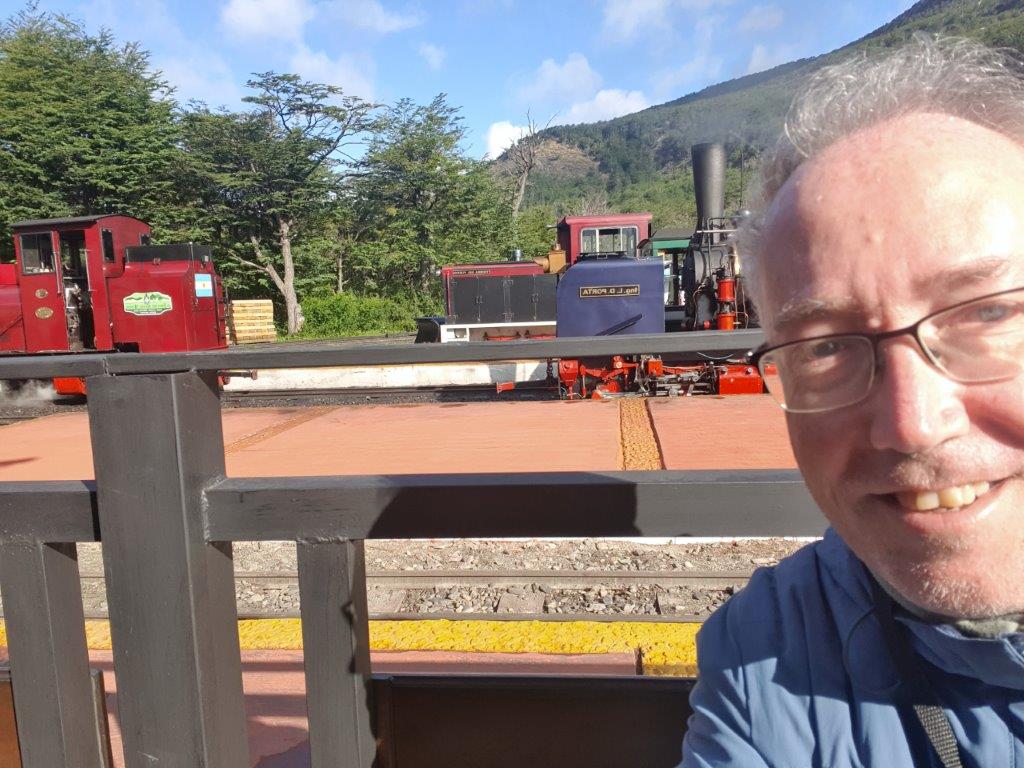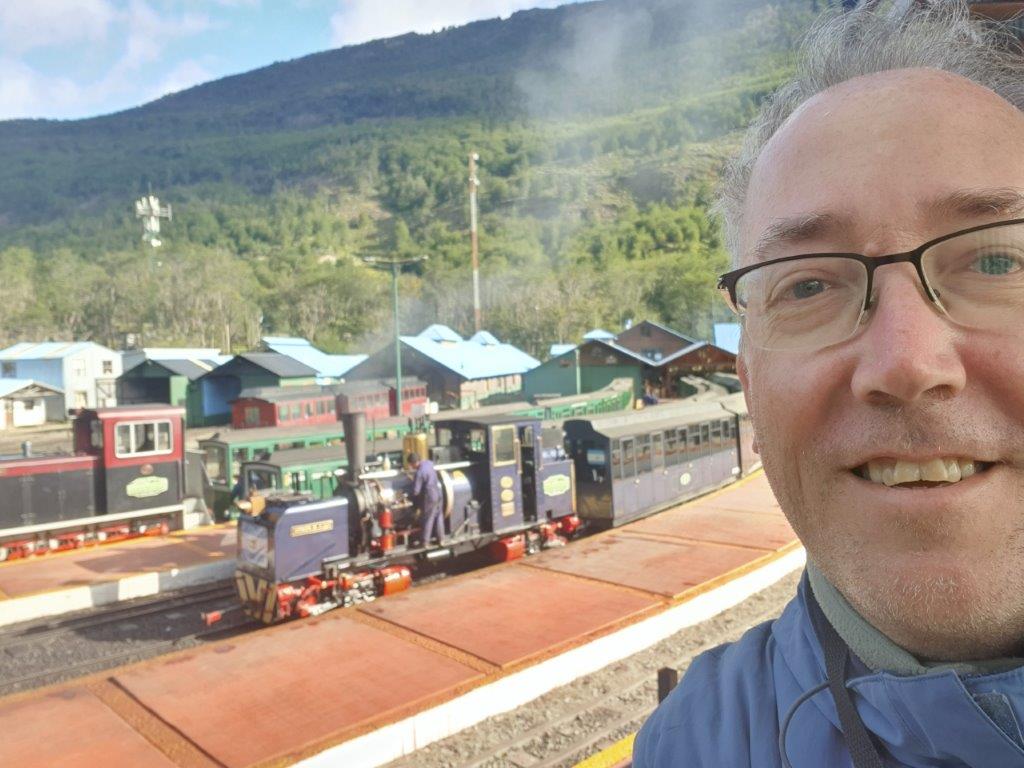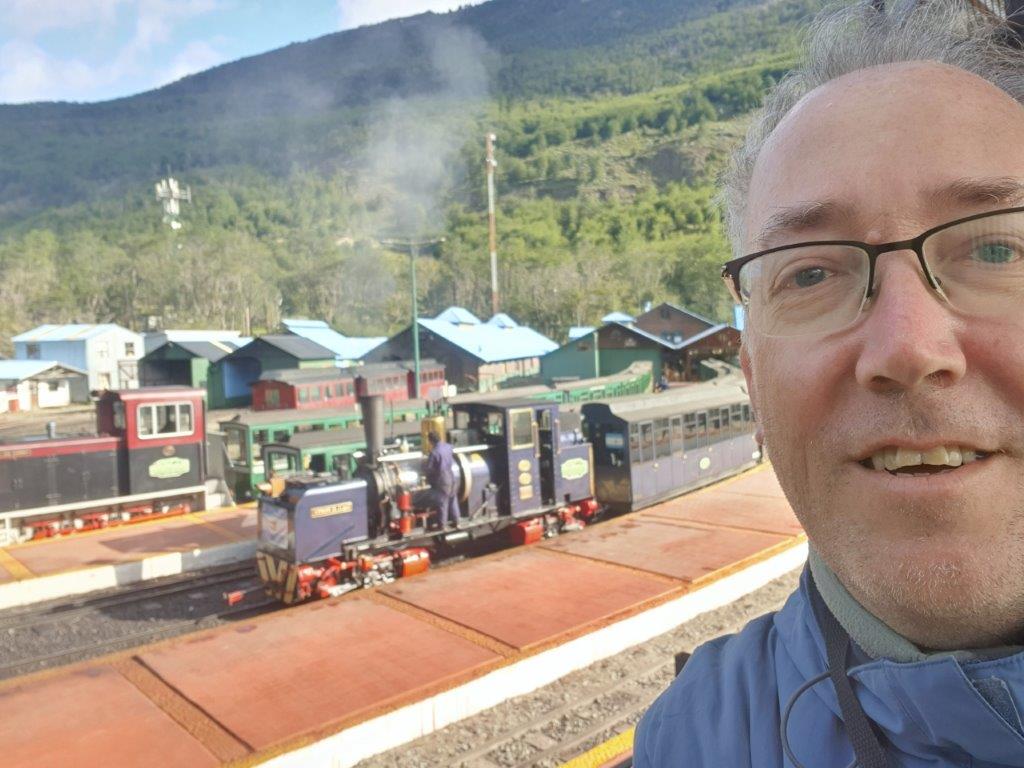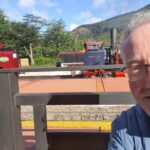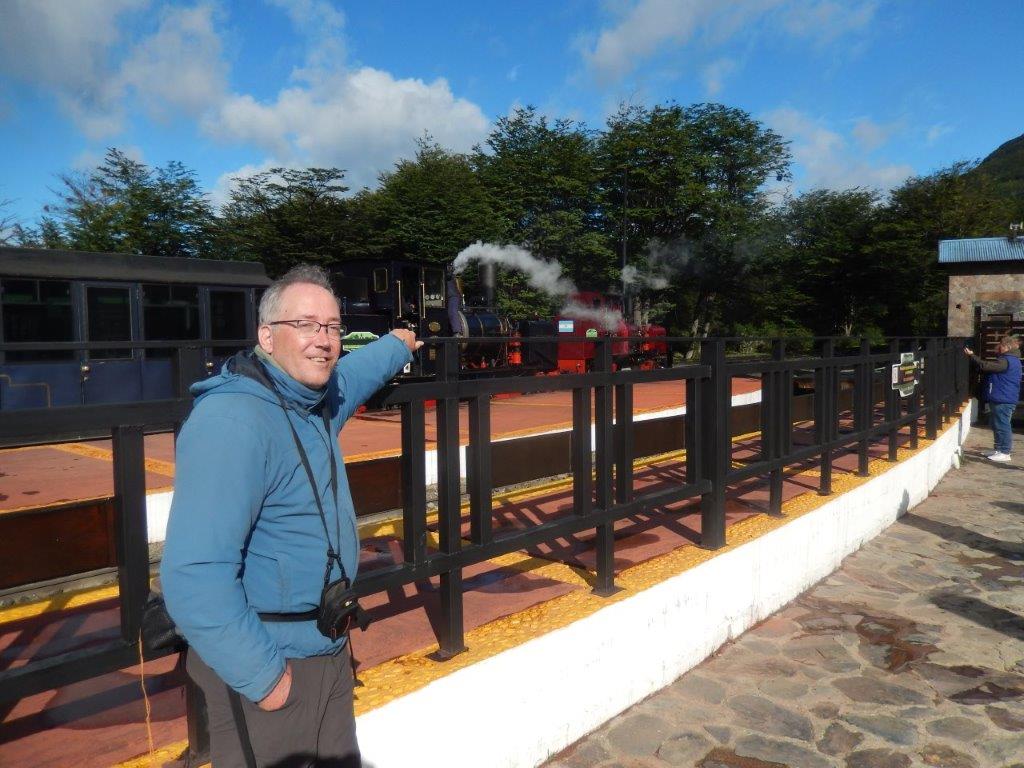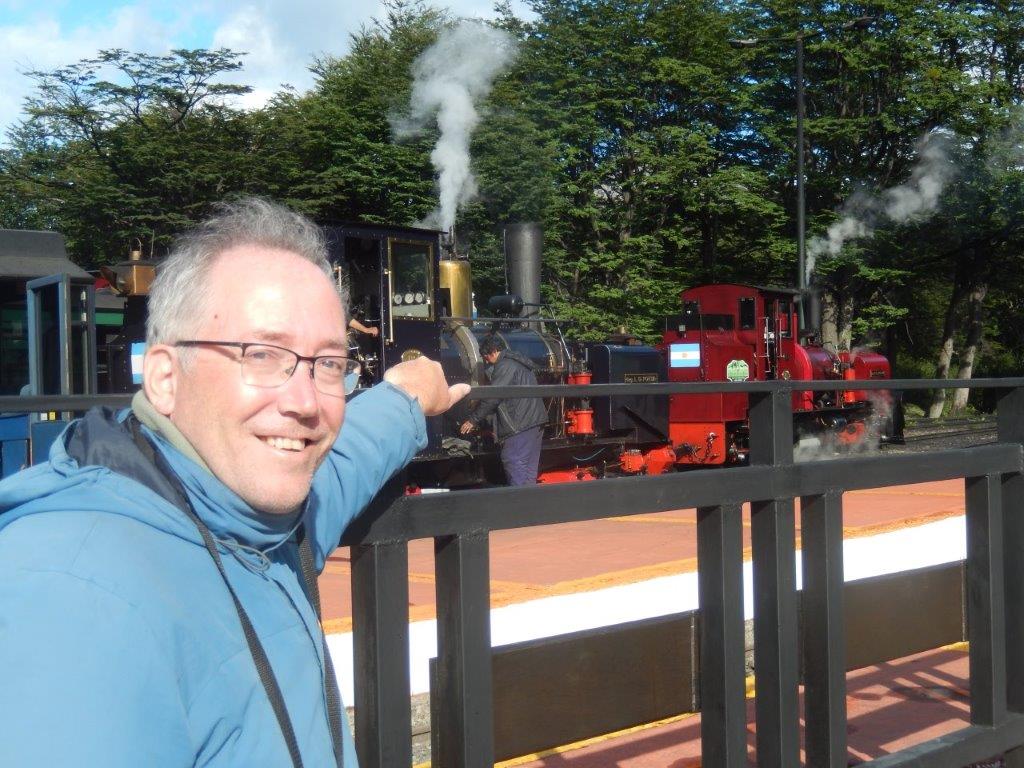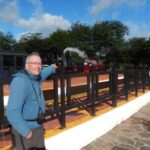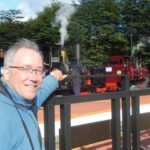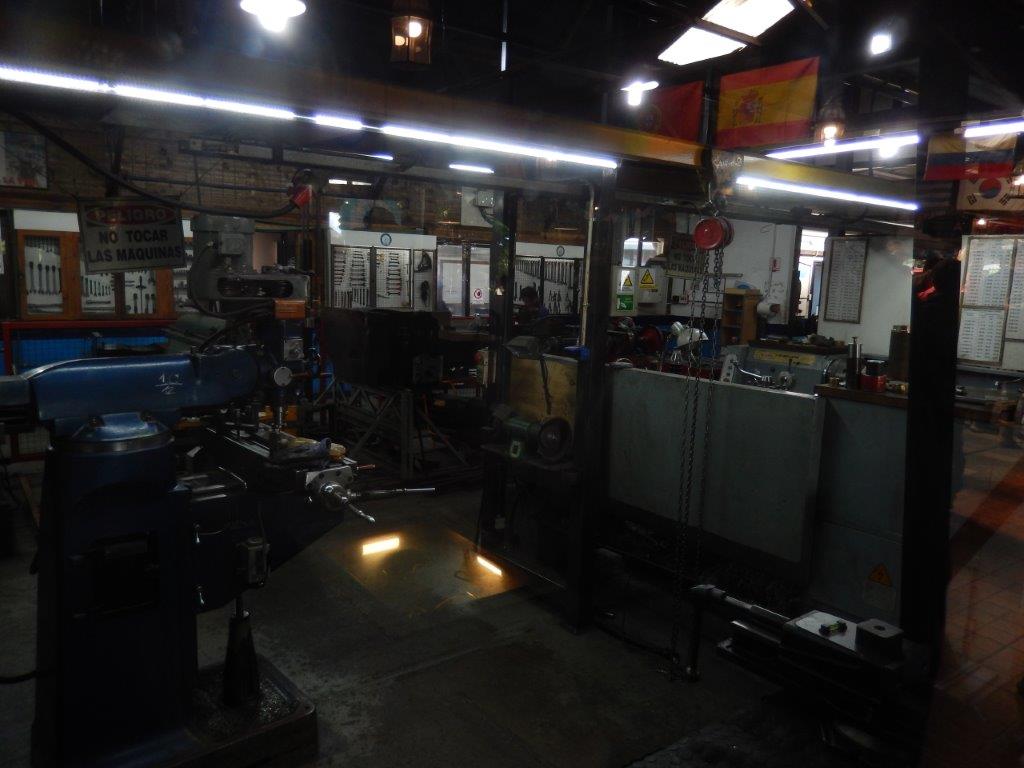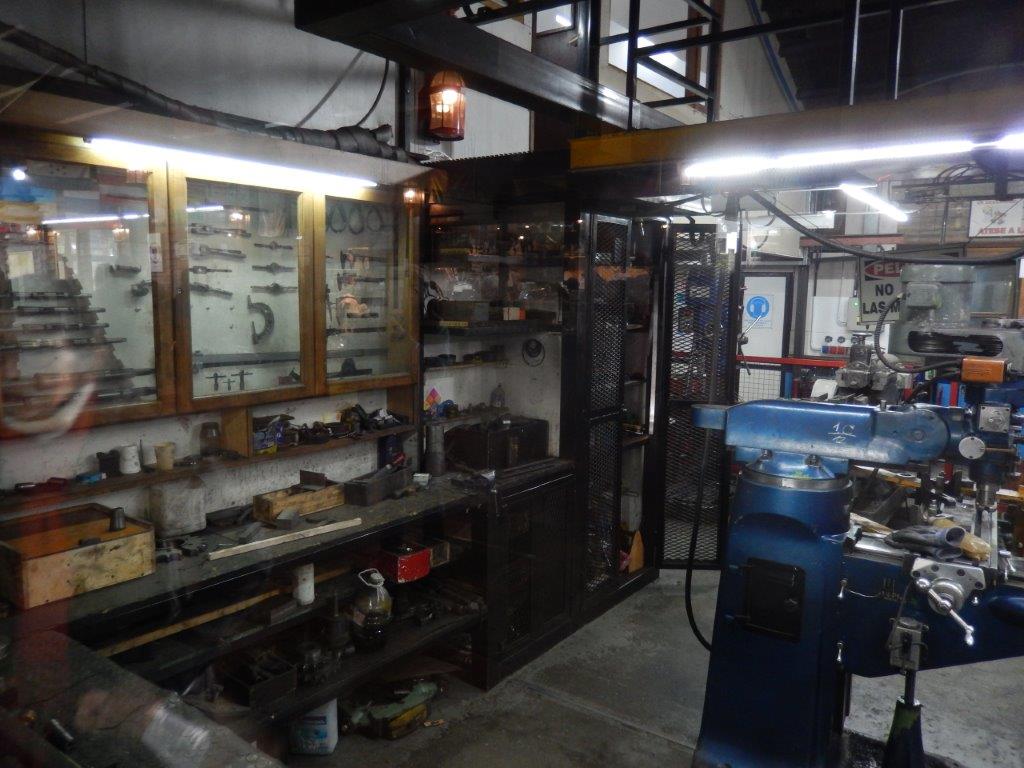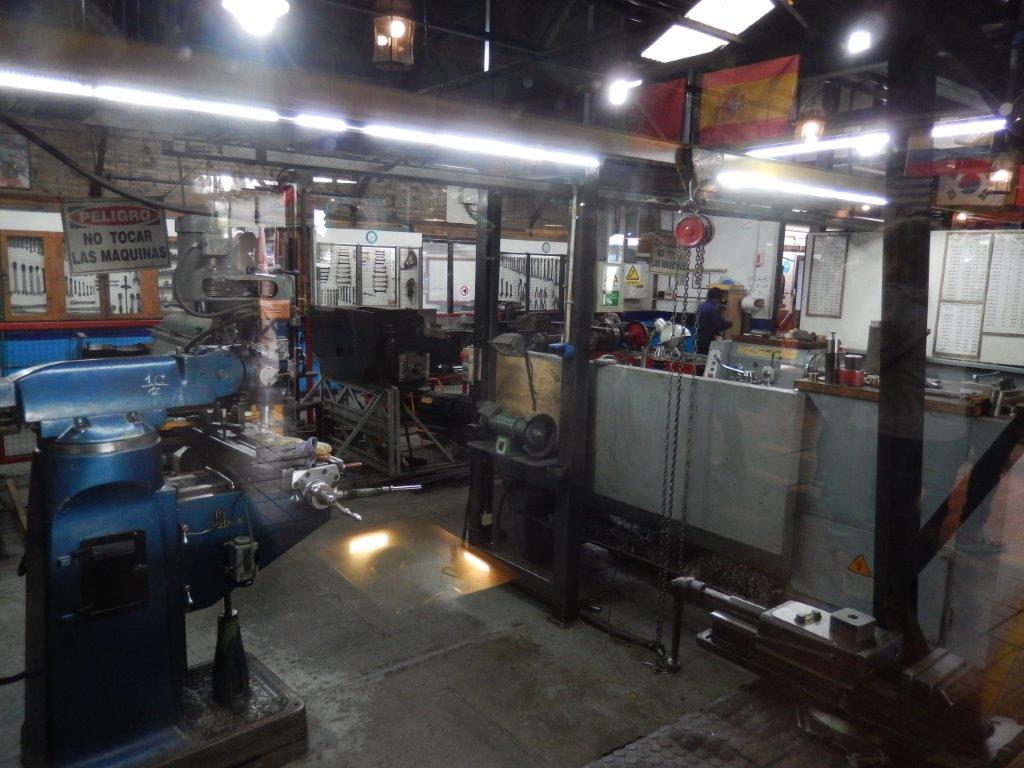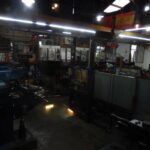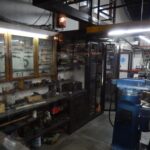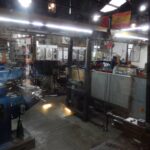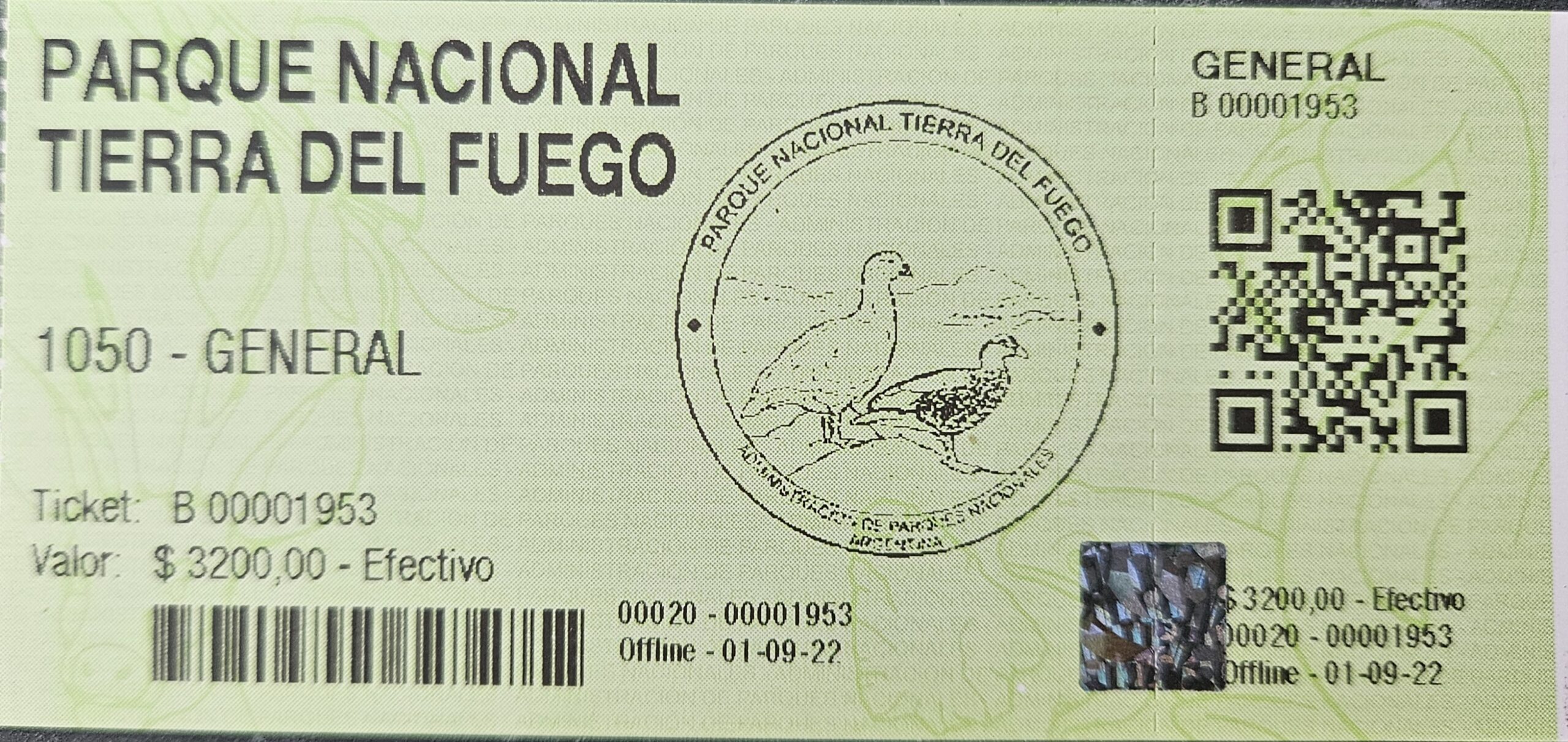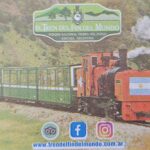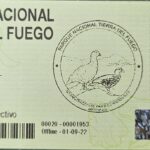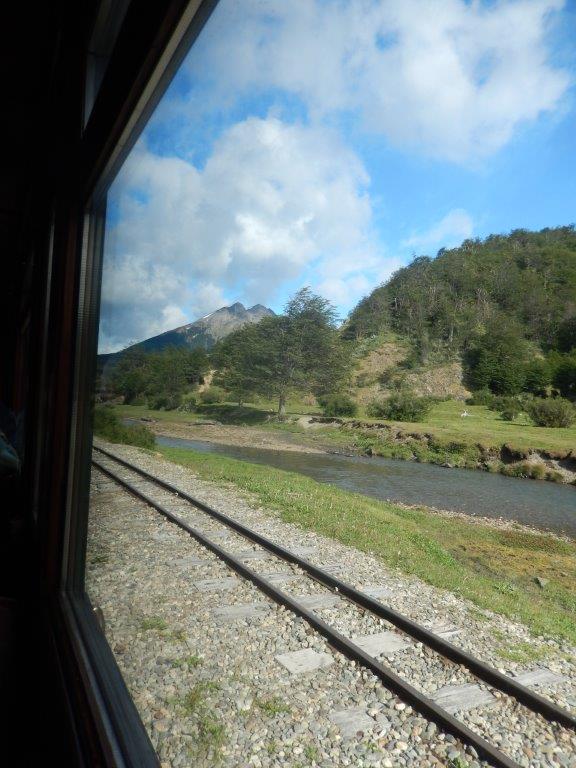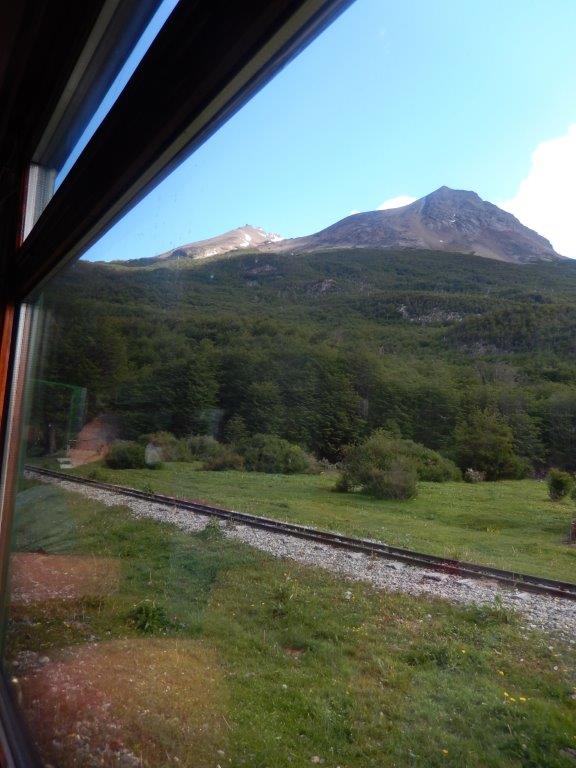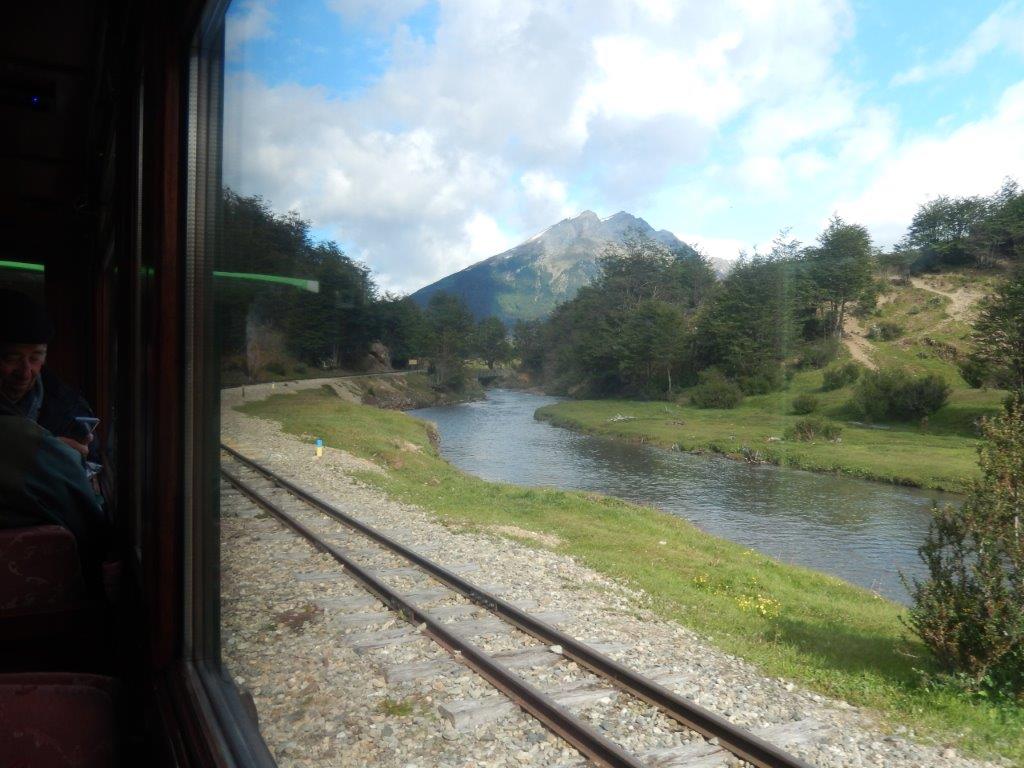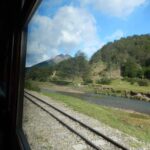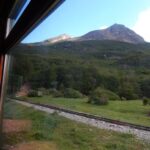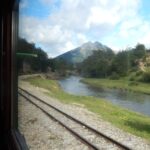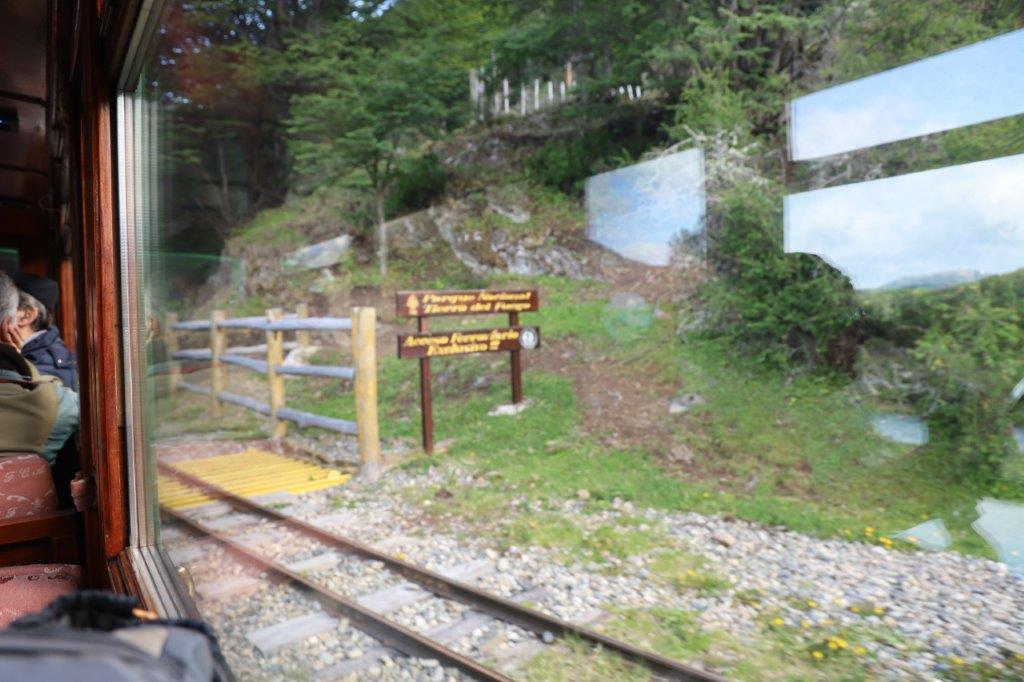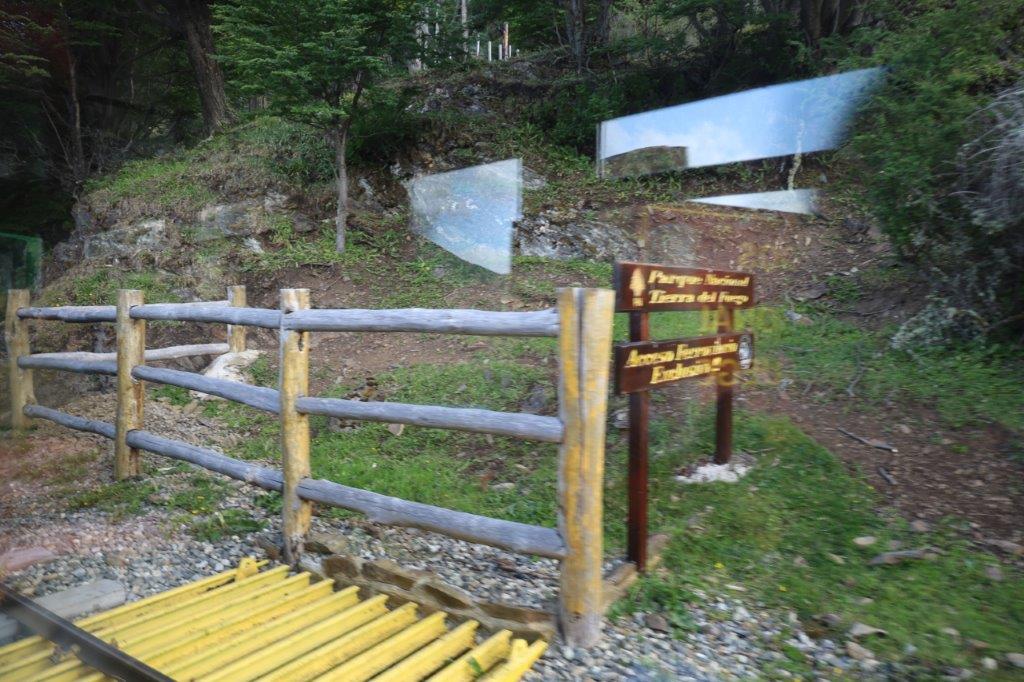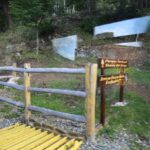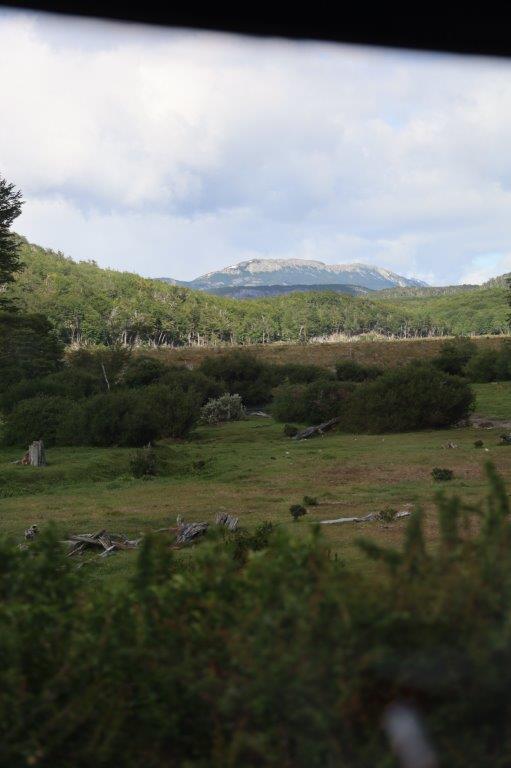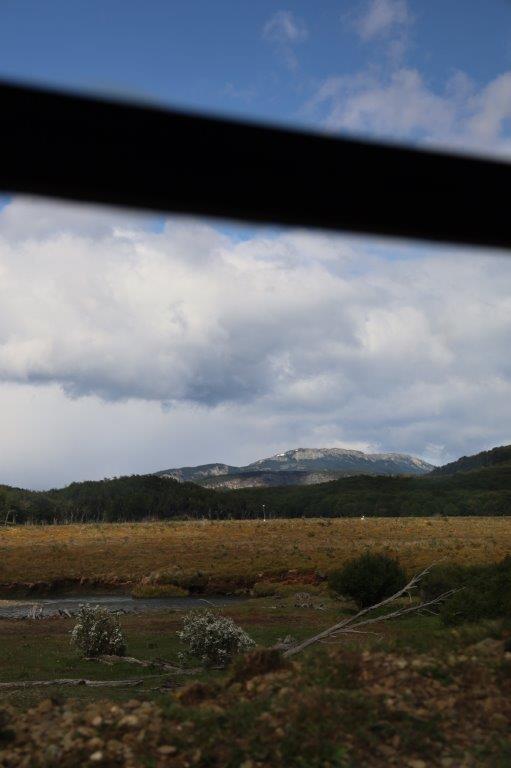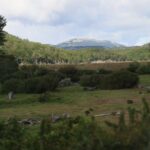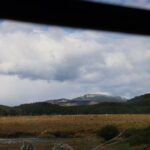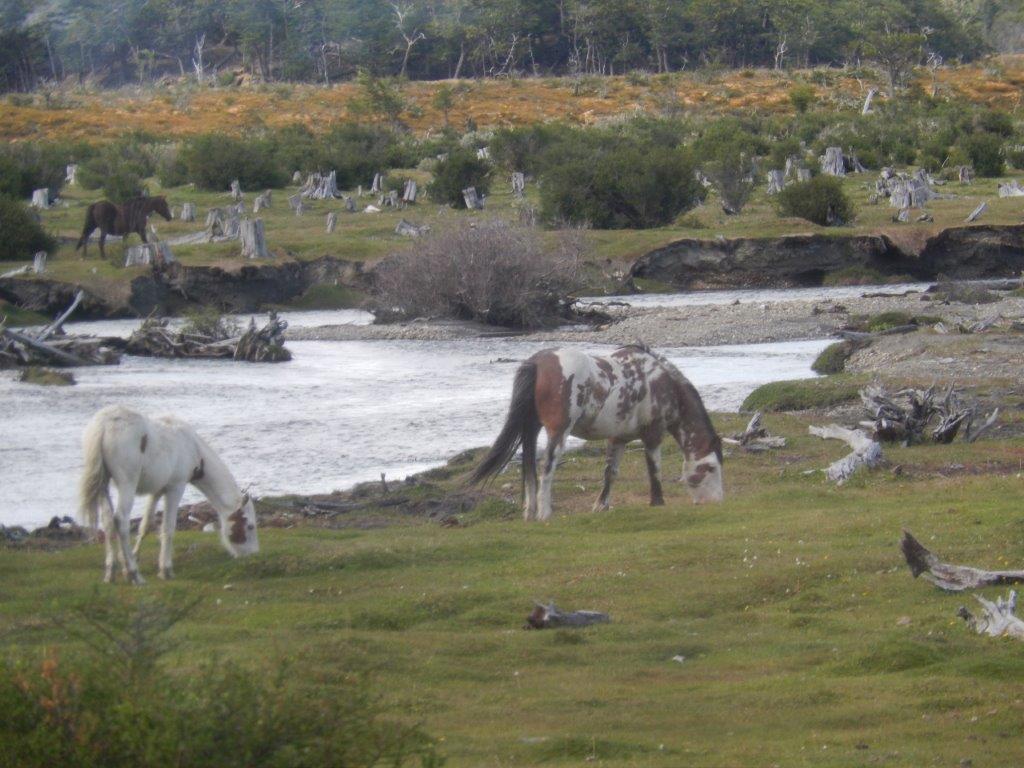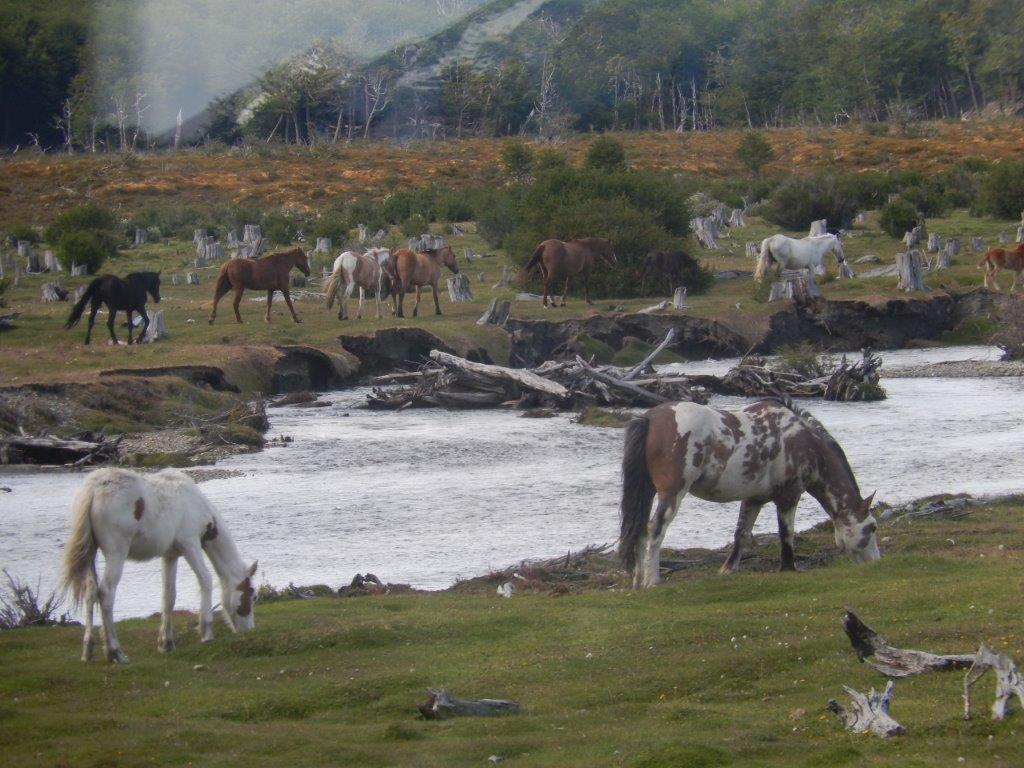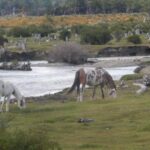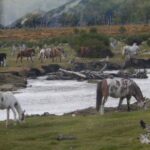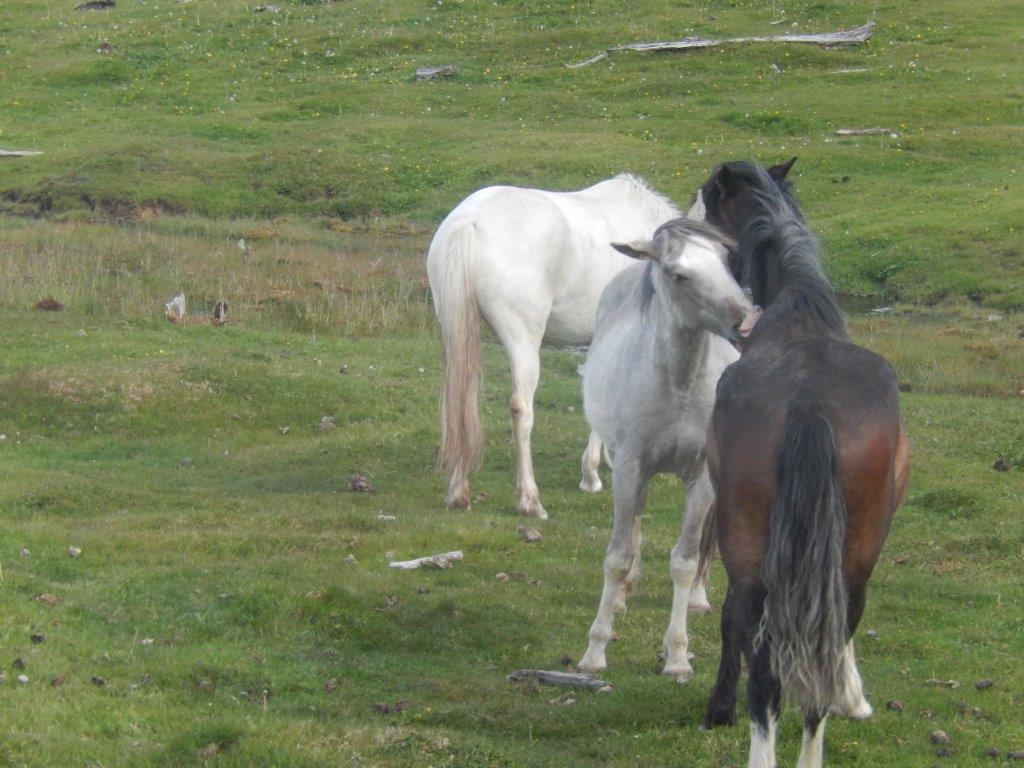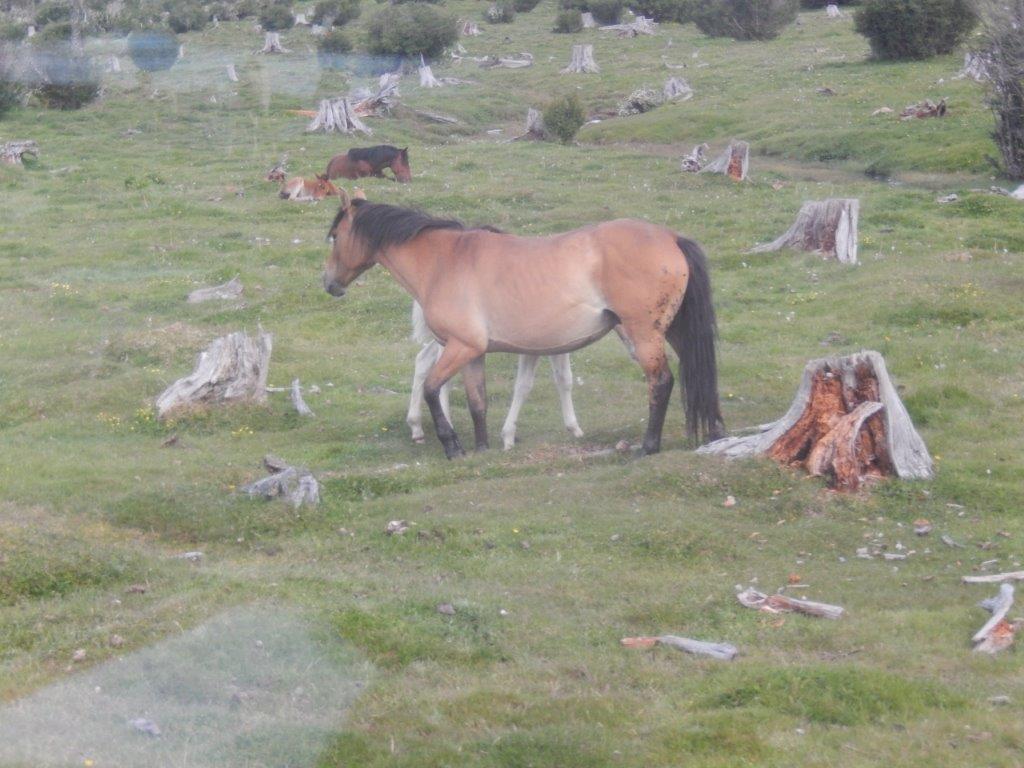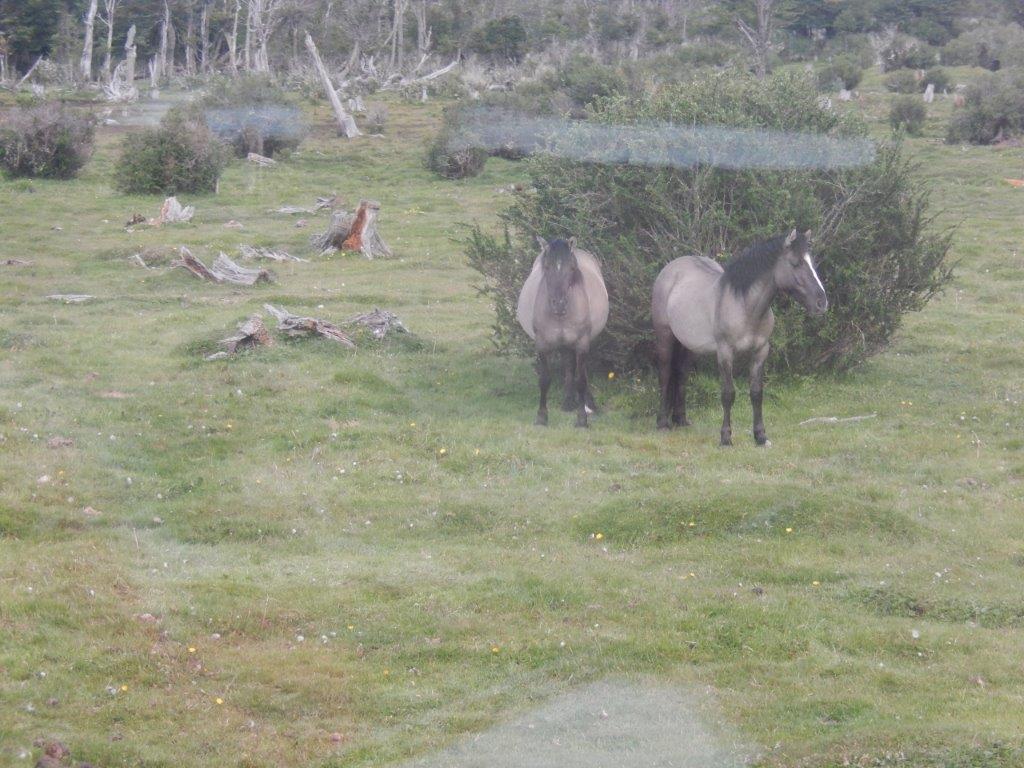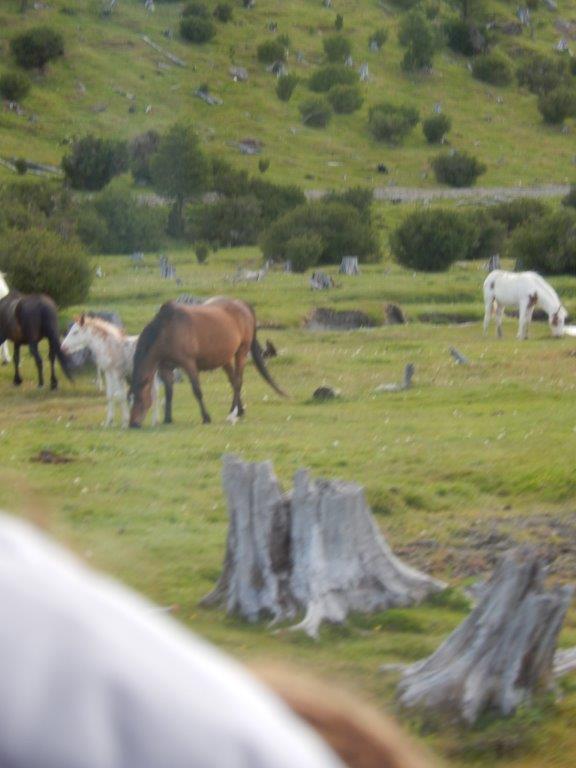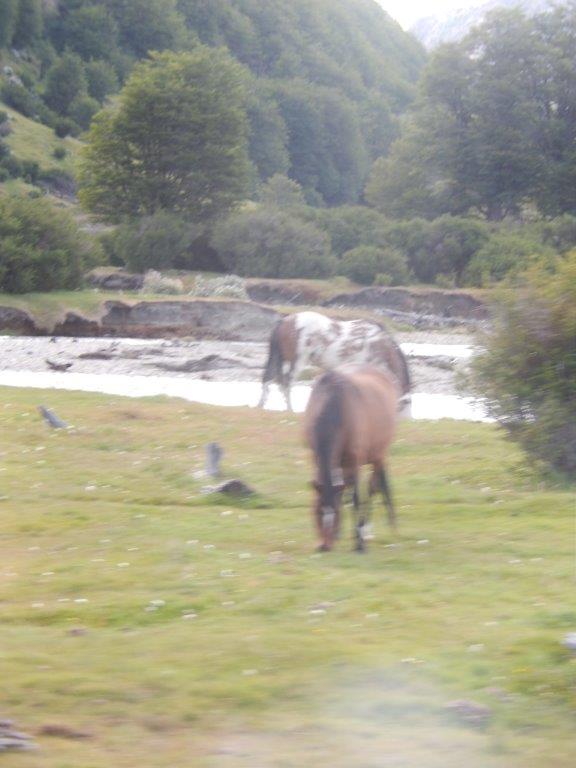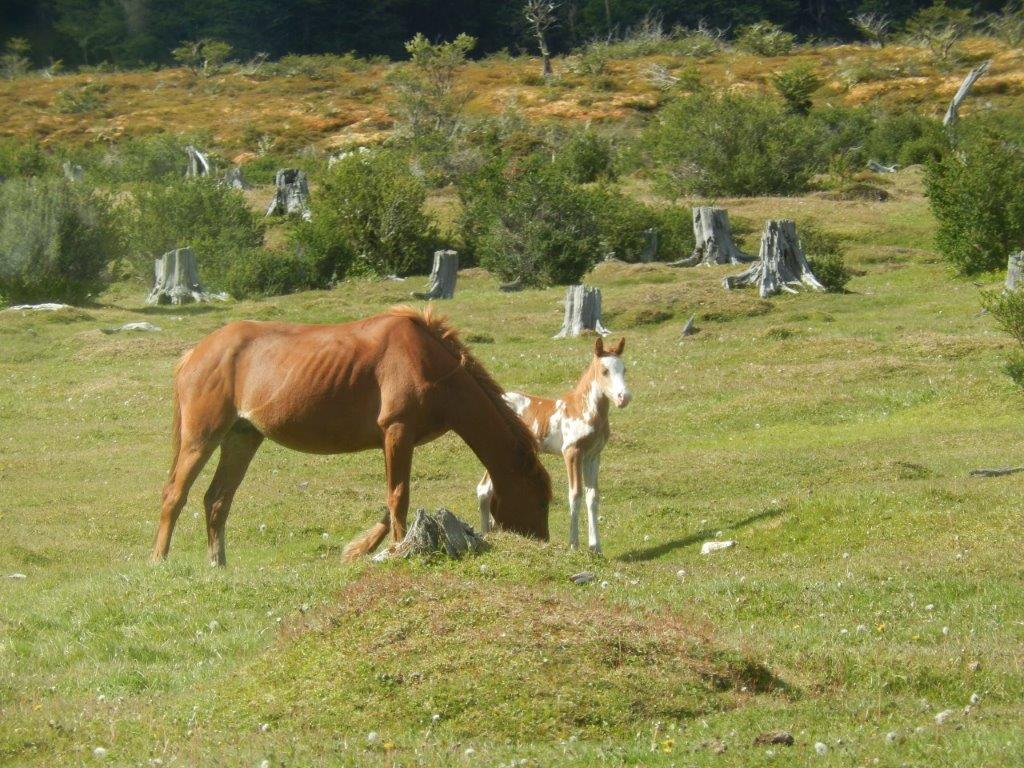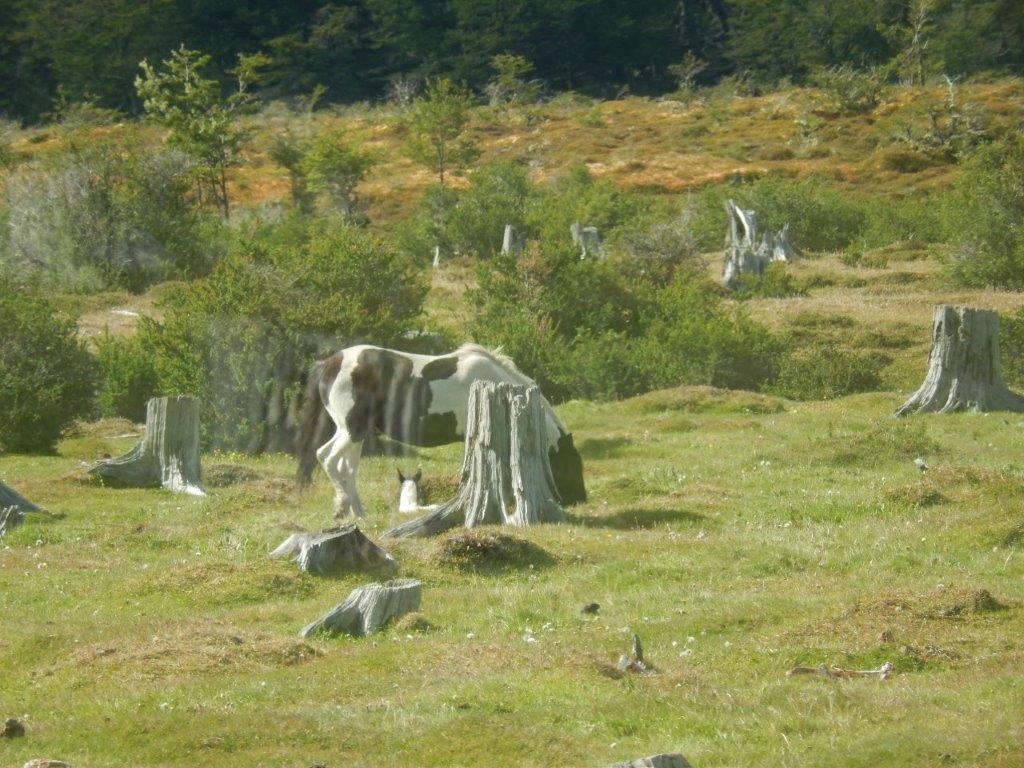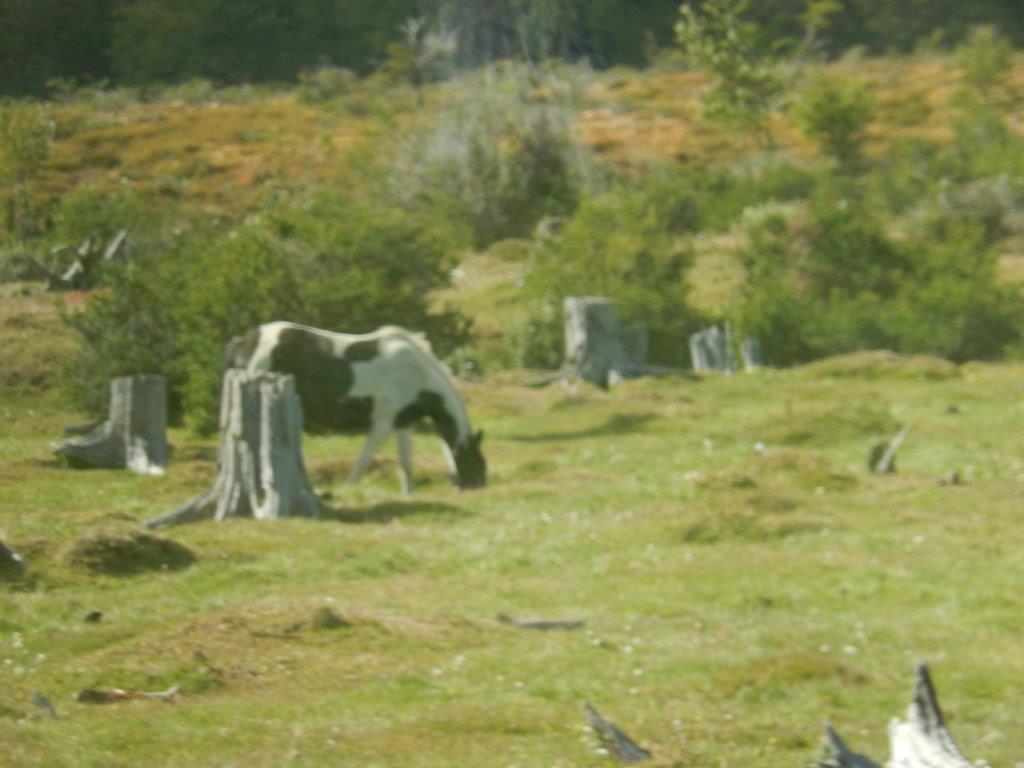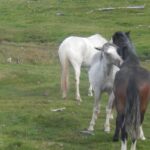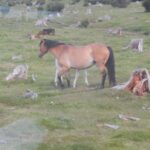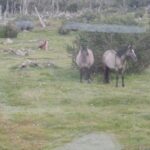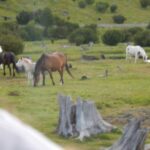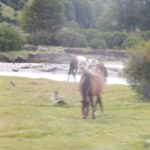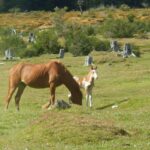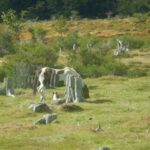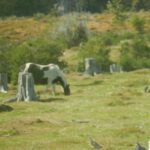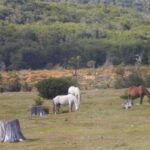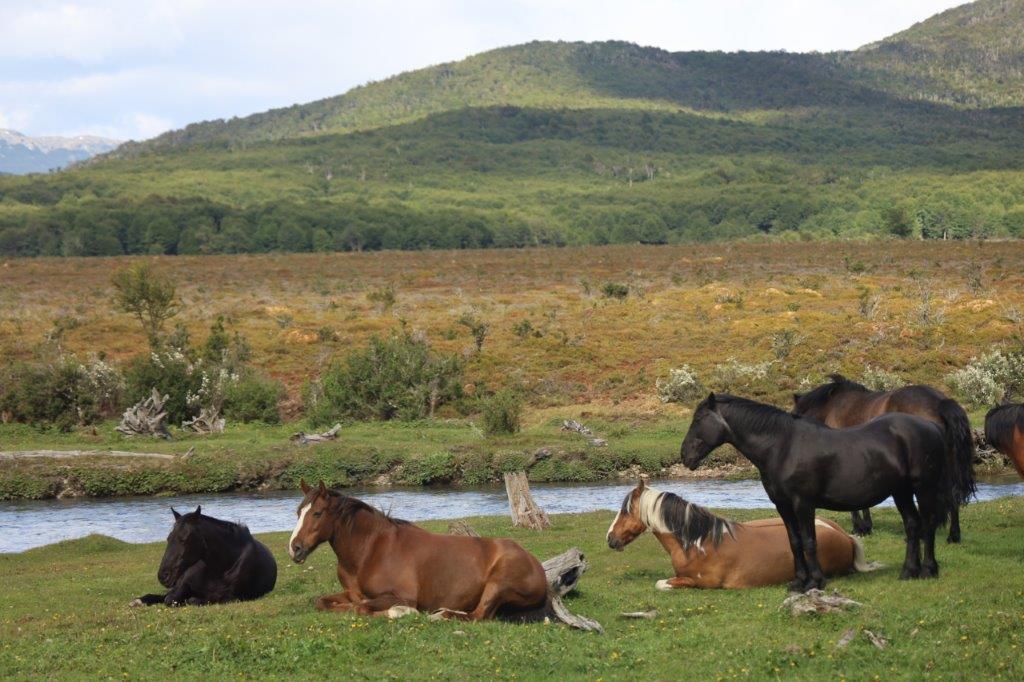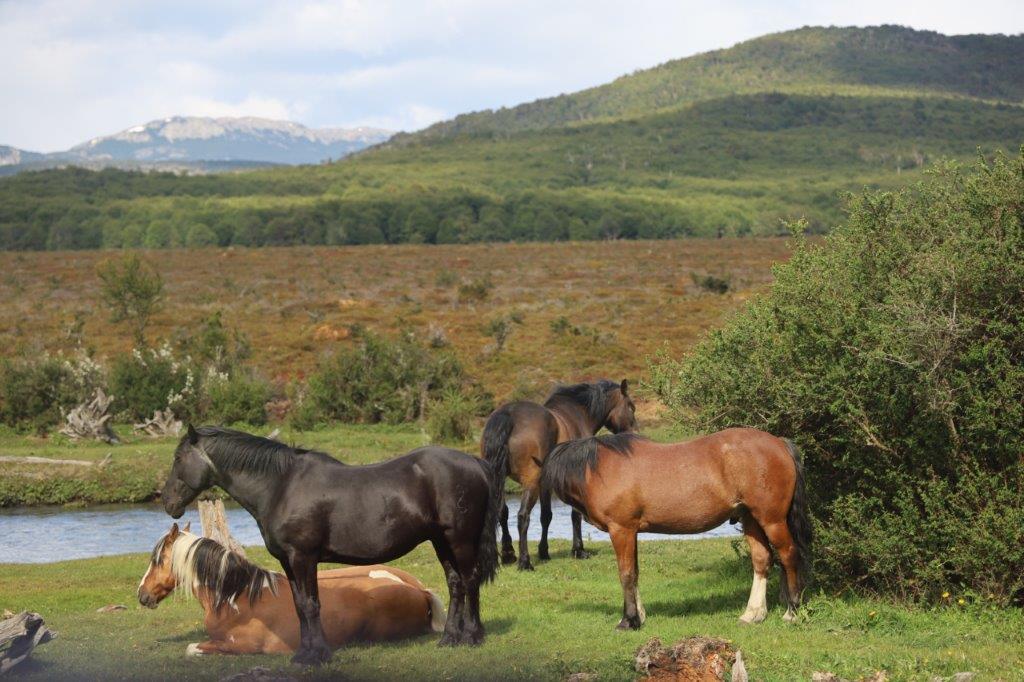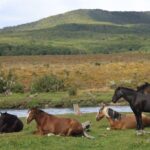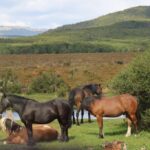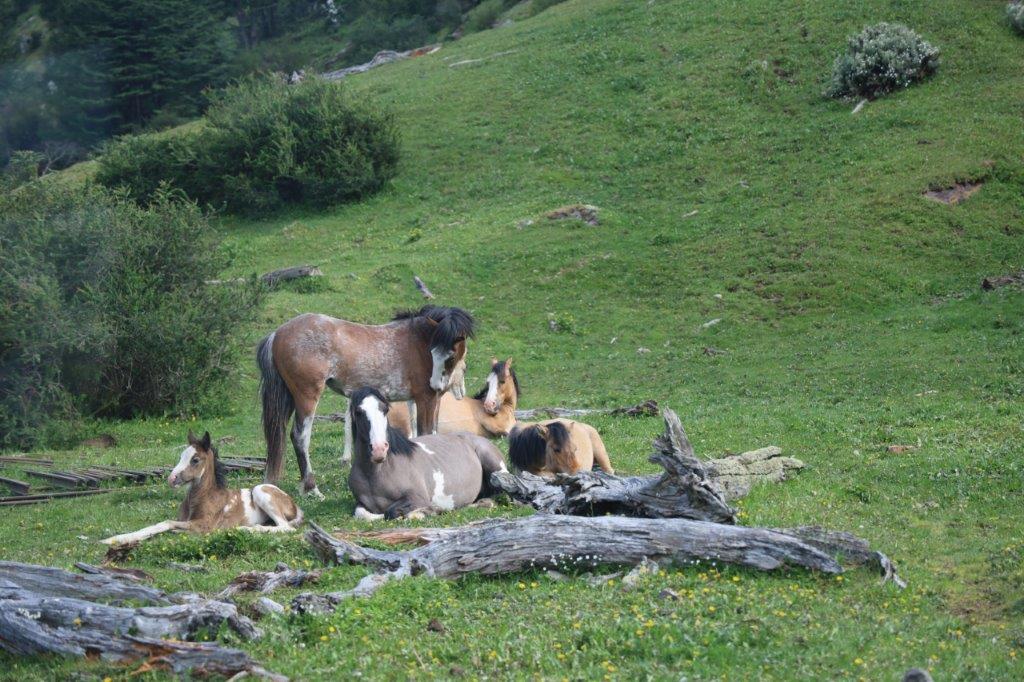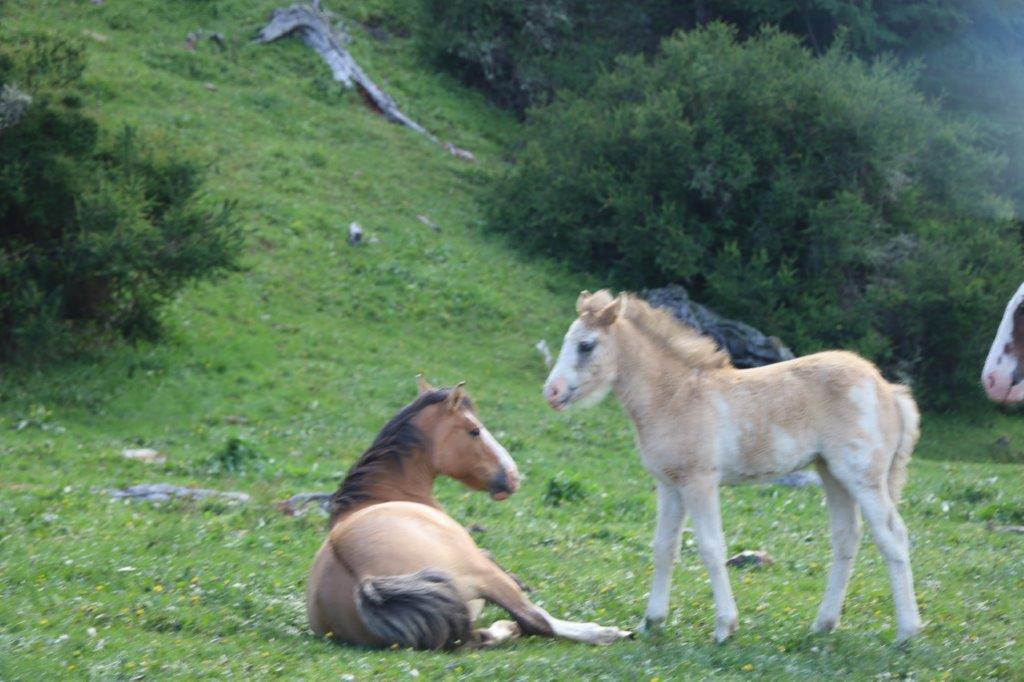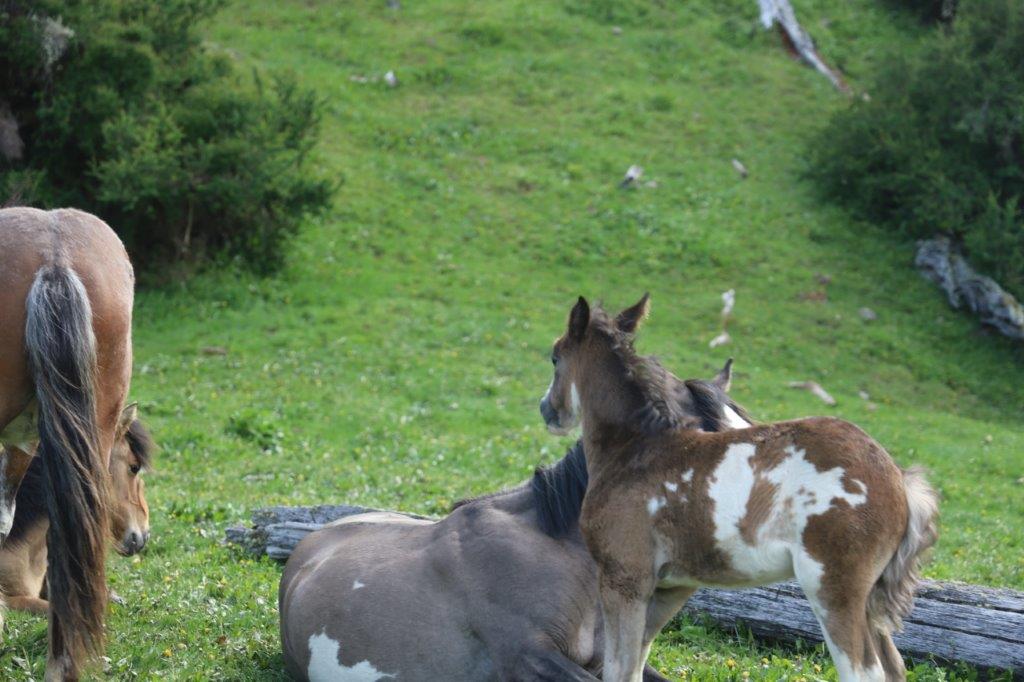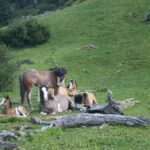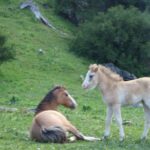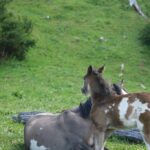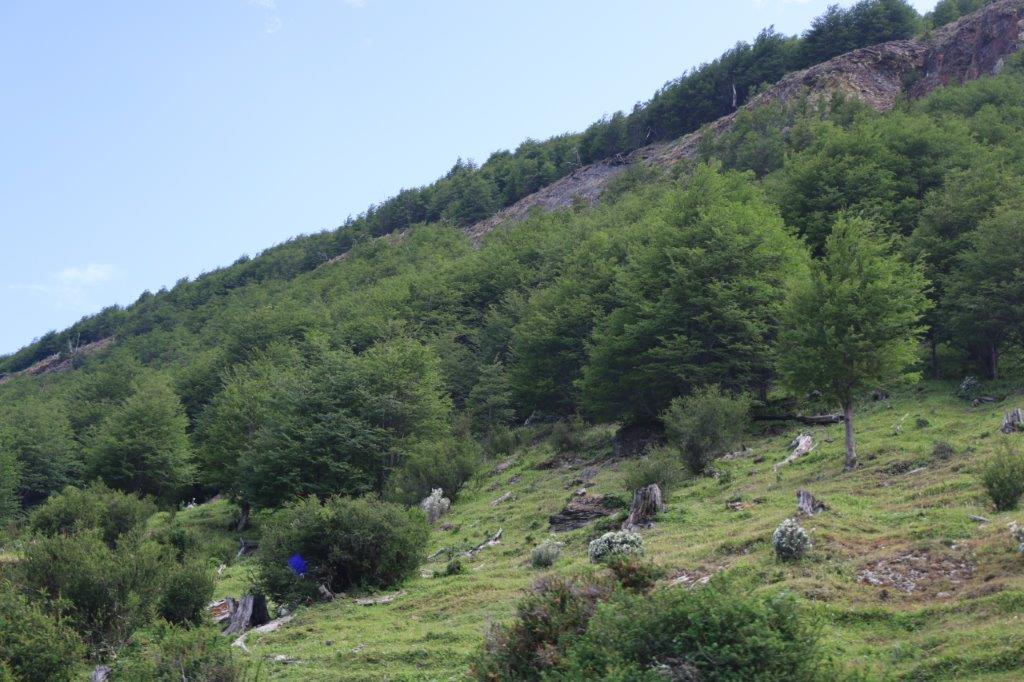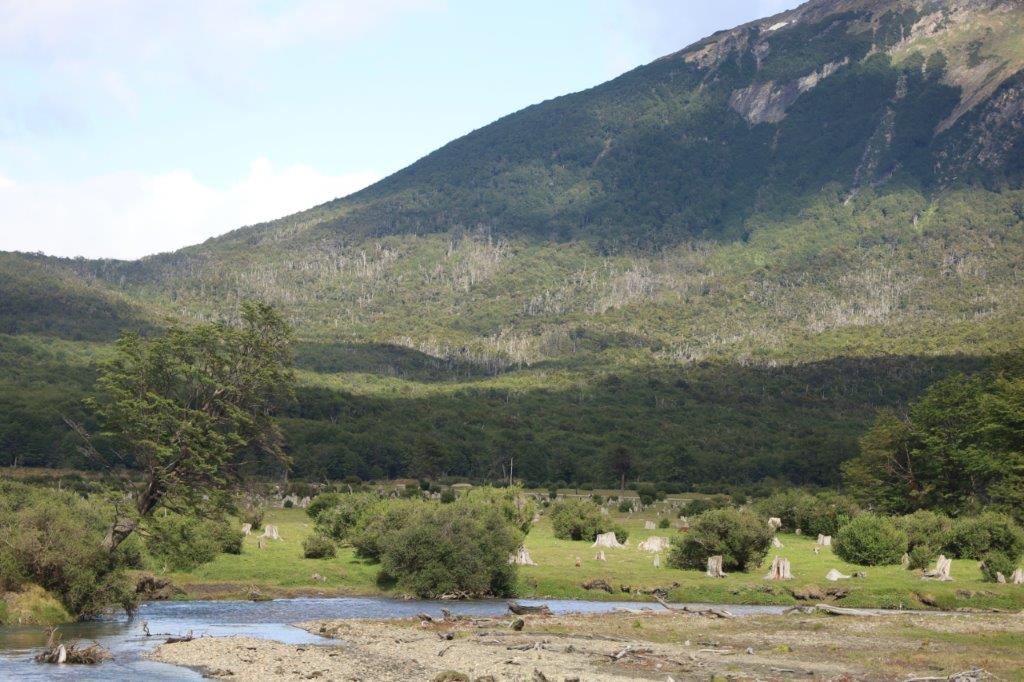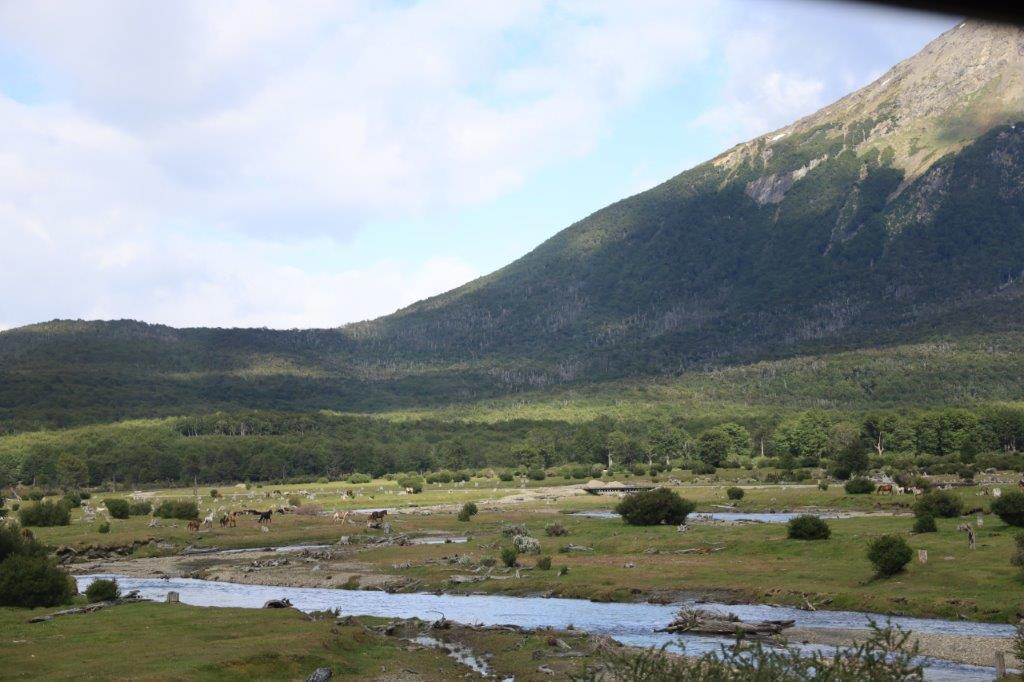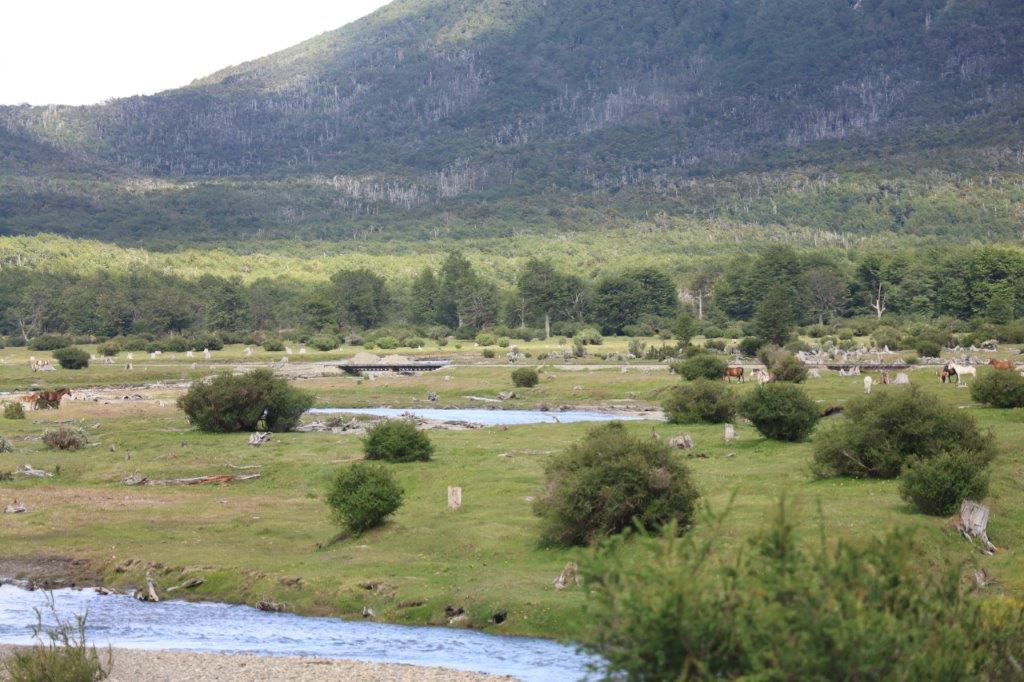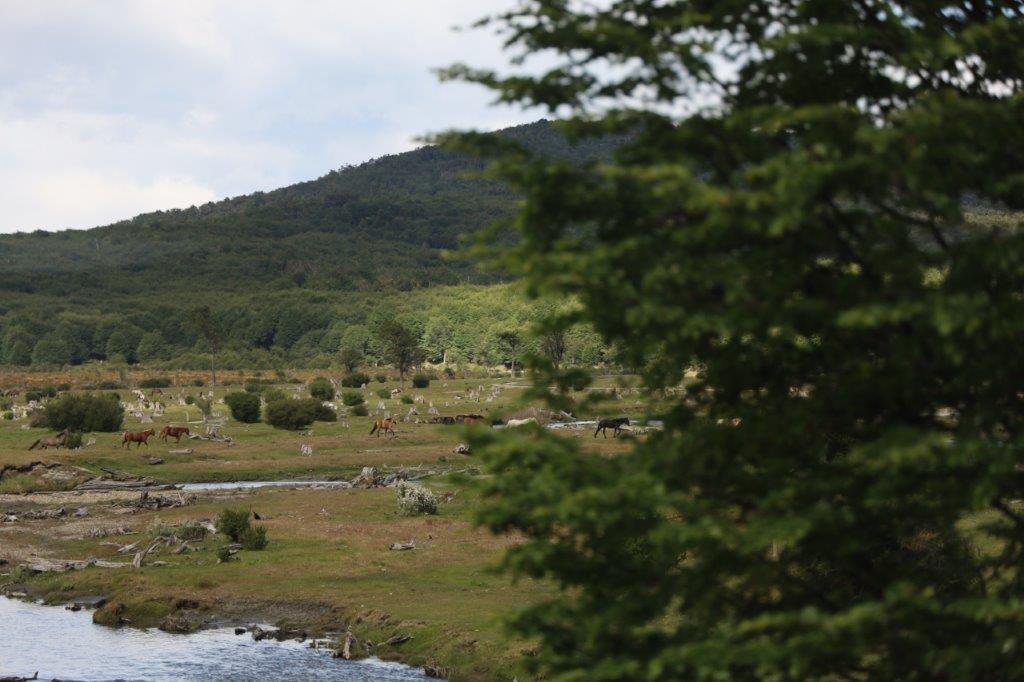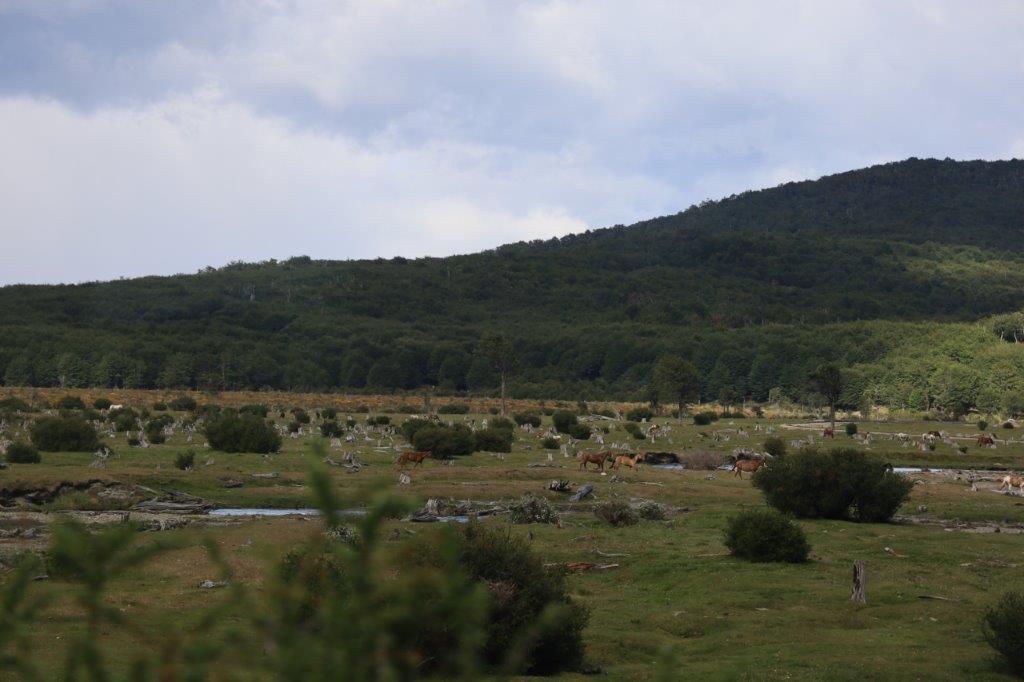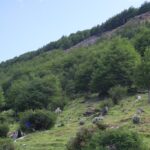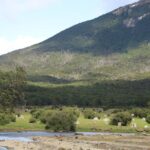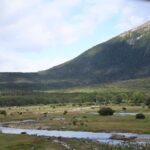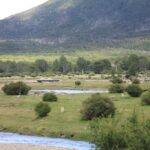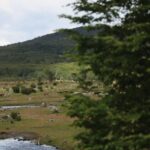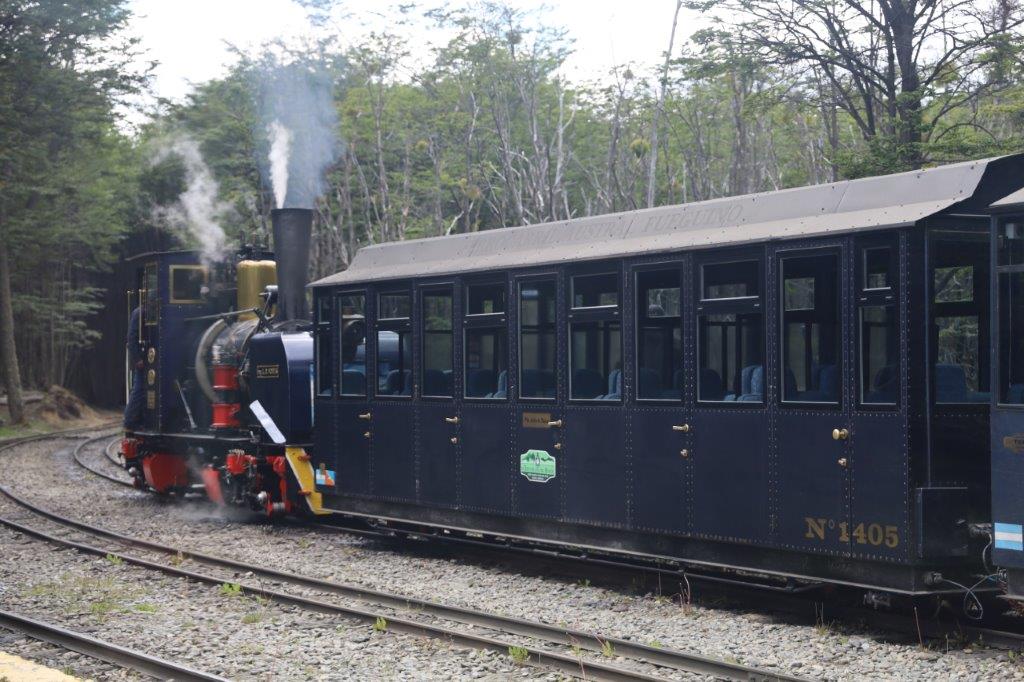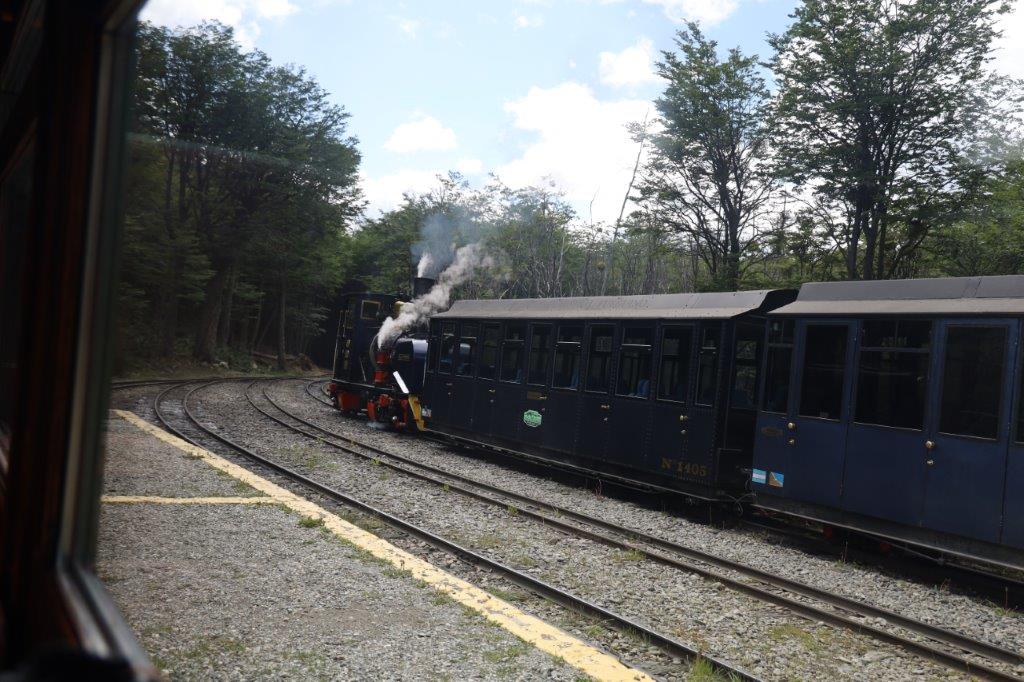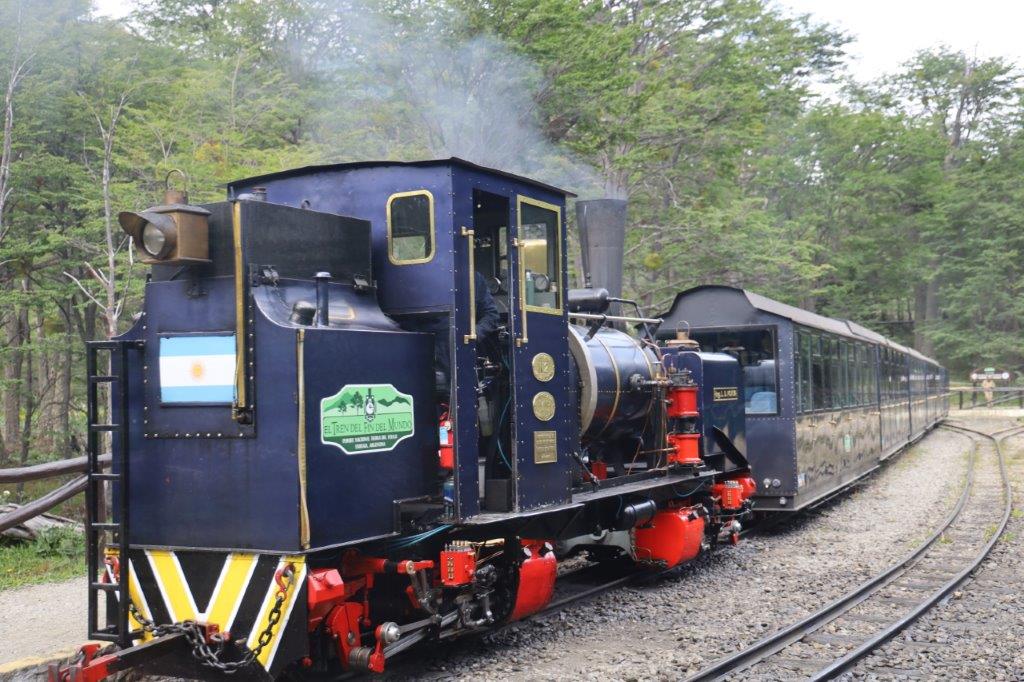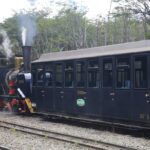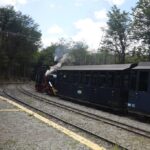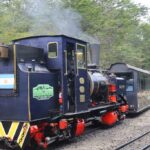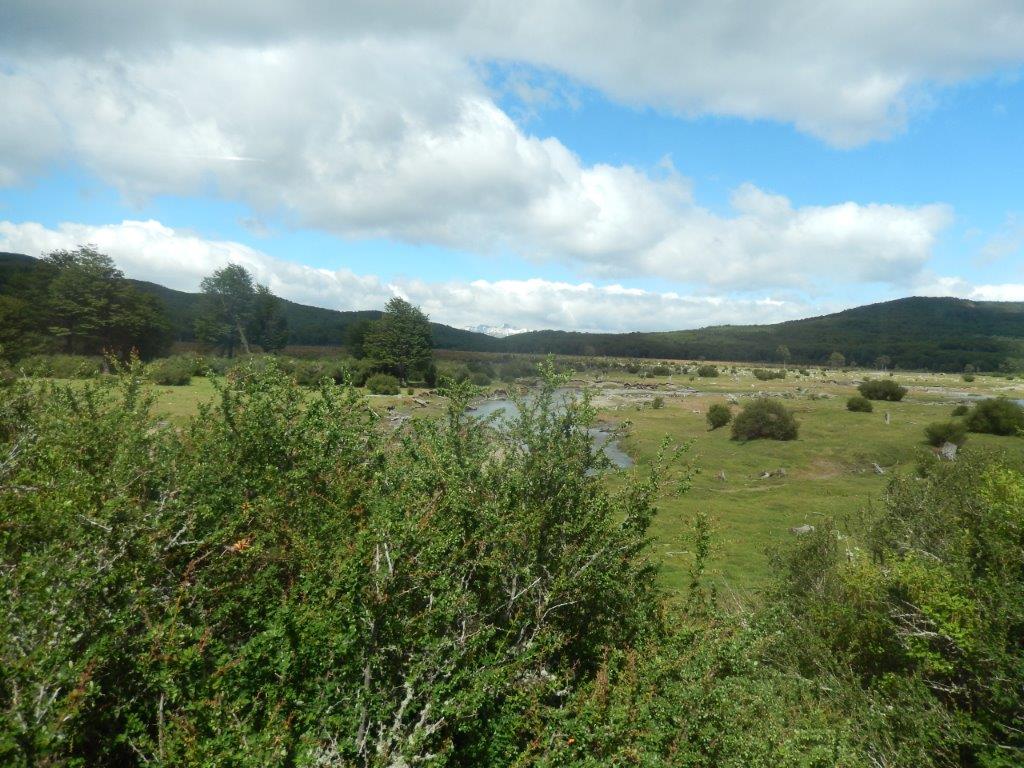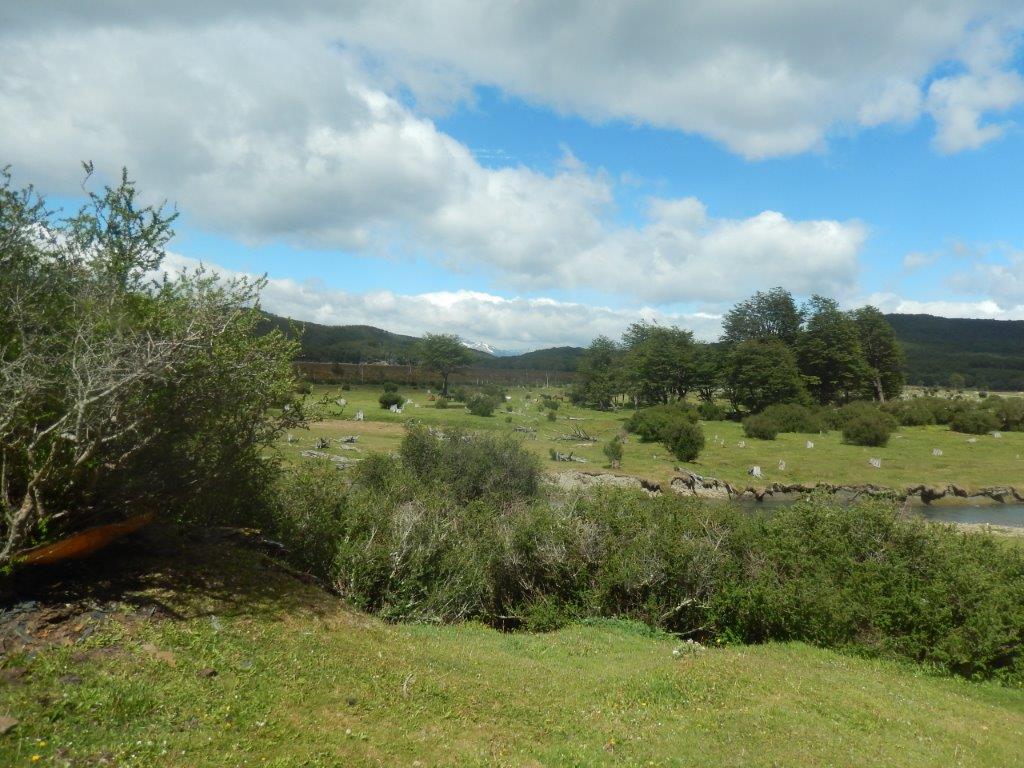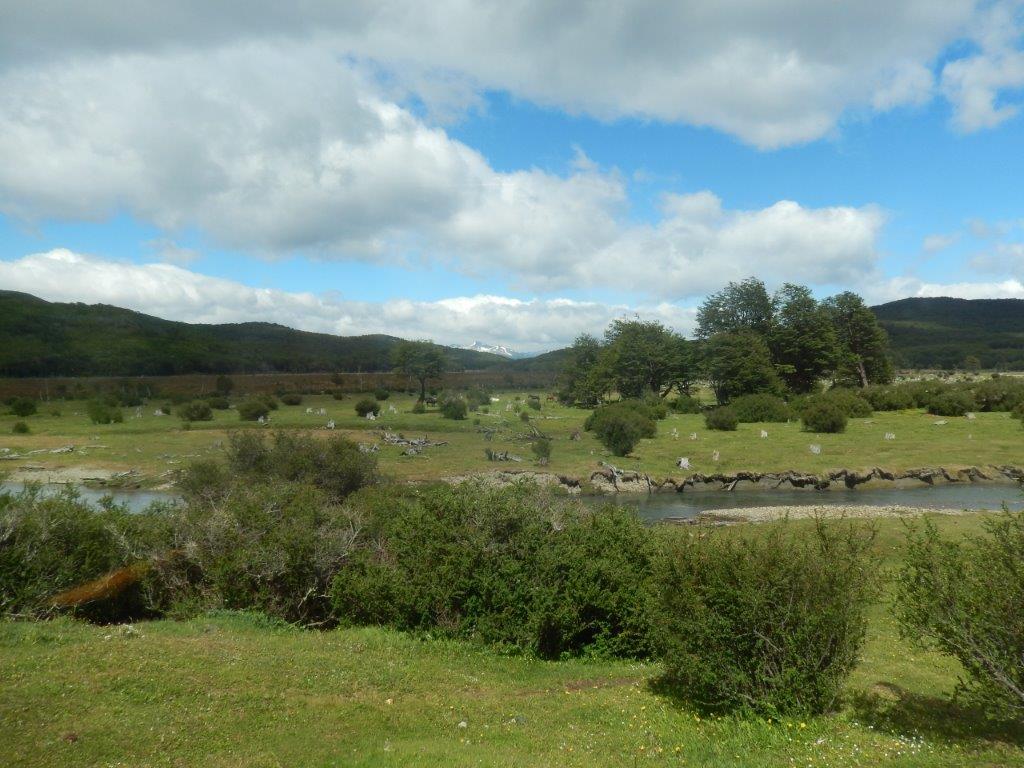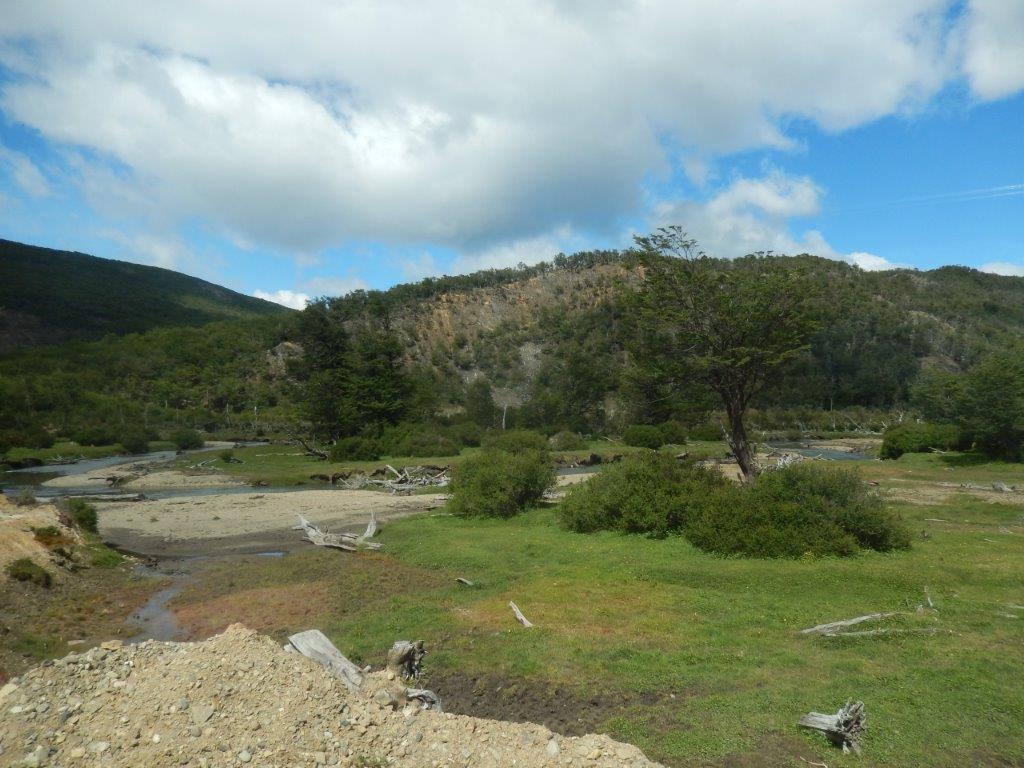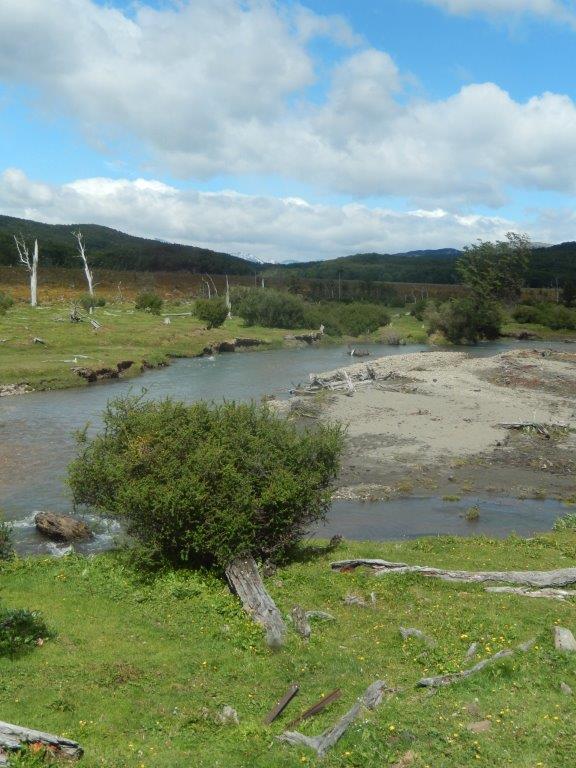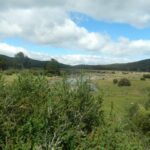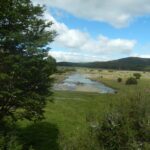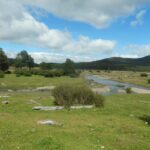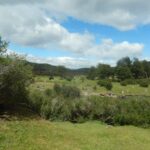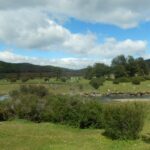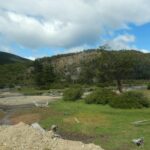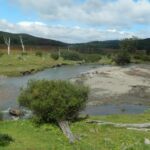44. Argentina: Tren al Fin del Mundo – (Tierra del Fuego National Park)
After an early rise and breakfast, The Wandelgek took a cab towards the Railway station of the Tren al Fin del Mundo,
The Train at the End of the World. If you read the blogpost:
…you’ll already know about the small railway built by prisoners in the days that Ushuaia was growing from a small village into the town it is now.
The exhibition showed many photographs of the prisoners building the railway into the forest, of the trains transporting the chopped wood and of the prisoners driving the train back and forth to Ushuaia.
At the Estacion Del Fin Del Mundo (1)
Ushuaia End of the World Station is a train station located on the outskirts of the city of Ushuaia in the Province of Tierra del Fuego, Antarctica and the South Atlantic Islands, Argentina . It operates as a tourist attraction, offering the End of the World Train service .
It has a ticket office, boutique, waiting room, bathrooms, and administrative offices.
This station is part of one of the three stations of the End of the World Train, which consists of a train that provides the service offered within the Tierra del Fuego National Park.
At the main railway station, outside at the platforms, were some old out of service locomotives and there was a watchtower, which might have been a watchtower for guards to keep the prisoners in sight…
 The Wandelgek had obtained an online tickets for a train ride back and forth into the Tierra del Fuego National Park…
The Wandelgek had obtained an online tickets for a train ride back and forth into the Tierra del Fuego National Park…
 The Wandelgek decided to climb the stairs of the watchtower and make some photo’s…
The Wandelgek decided to climb the stairs of the watchtower and make some photo’s…
 The Southern Fuegian Railway (Spanish: Ferrocarril Austral Fueguino (FCAF)) or the Train at the End of the World (Spanish: El Tren del Fin del Mundo) is a 500 mm (19+3⁄4 in) gauge steam railway in Tierra del Fuego Province, Argentina.
The Southern Fuegian Railway (Spanish: Ferrocarril Austral Fueguino (FCAF)) or the Train at the End of the World (Spanish: El Tren del Fin del Mundo) is a 500 mm (19+3⁄4 in) gauge steam railway in Tierra del Fuego Province, Argentina.
It was originally built as a freight line to serve the prison of Ushuaia, specifically to transport timber. It now operates as a heritage railway into the Tierra del Fuego National Park and is considered the southernmost functioning railway in the world.
It was very interesting to see technicians prepare their locomotives. Not only were they preparing them for the upcoming train rides but they were cleaning them quite fanatically too…
 There was still some time to pass before the train would leave the station…
There was still some time to pass before the train would leave the station…
After enjoying some more of the railroad activity, which reminded him of his model railroad tracks from his youth, he proceeded towards the station building.
 In the late 19th century, Ushuaia on Isla Grande de Tierra del Fuego developed as a penal colony, with the first prisoners arriving in 1884. In 1902, work began on a proper set of buildings for the prison by inmates, and a railway on wooden rails was constructed to assist the transport of materials, mainly local rock, sand and timber.
In the late 19th century, Ushuaia on Isla Grande de Tierra del Fuego developed as a penal colony, with the first prisoners arriving in 1884. In 1902, work began on a proper set of buildings for the prison by inmates, and a railway on wooden rails was constructed to assist the transport of materials, mainly local rock, sand and timber.
Oxen pulled wagons along the narrow gauge of less than 1,000 mm (3 ft 3+3⁄8 in) metre gauge. In 1909, the prison governor informed the government of the need to upgrade the line and Decauville tracks at a 600 mm (1 ft 11+5⁄8 in) narrow gauge were laid in 1909 and 1910 for use with a steam locomotive. They connected the prison camp with the forestry camp and passed along the shoreline in front of the growing town of Ushuaia. It was known as the ‘Train of the Prisoners’ (Tren de los Presos) and brought wood for heating and cooking as well as building.
The railway was gradually extended further into the forest into more remote areas as wood was exhausted. It followed the valley of the Pipo River into the higher terrain. Constant building allowed expansion of the prison and of the town, with prisoners providing many services and goods.
In 1947 the prison was closed and replaced with a naval base. Two years later the 1949 Tierra del Fuego earthquake blocked much of the line. Nevertheless, the government made efforts to clear the line and put the train back in service despite the absence of the prisoners. However the service was not viable and closed in 1952.
 Rebirth as a tourist railway
Rebirth as a tourist railway
In 1994, the railway was rebuilt in 500 mm (19+3⁄4 in) track gauge and began services again, although now in luxury relative to its origin as a prison train, with champagne and dinner services. A new 2-6-2T steam locomotive (Camila) was brought from England in 1995 with another made in Argentina and three diesel locomotives also serving on the line. Two garratts, in Porta’s improved version, have also been procured.
Services leave from the ‘End of the World’ station (about 10 km west of Ushuaia’s Airport and immediately west of the Ushuaia Golf Club). The route takes passengers along the Pico Valley in the Toro gorge and to Cascada de la Macarena station where visitors are able to learn about the Yámana people and climb to a viewpoint at a 15-minute stop. The train then enters the national park and the forest, travelling through the valley below the mountains, reaching El Parque station where tourists can return by coach or train.
There is a plan to extend the line to a new station closer to Ushuaia and connect the station to the city with a tram.
Tiny railroad museum
Inside the station building, was a lot of railroad history exposed to take in…

The walls were decorated with lots of old historic photographs from the days when prisoners worked in this area to chop trees…

The new trains were an example for those later used in Disneyland…

It was also possible to visit the components reparation workshop. It was loaded with repair tools of all sorts and sizes …
IMPORTANT PRACTICAL TIP: Then it was time to go out on to the platform. Remember that this train ride enters the National Park.
To enjoy the full ride, you need train tickets and National Park entrance tickets, which you need to pursue seperately, unless you’re taking a tour from Ushuaia. Then the tour operator will provide those for you.

The prisoners were preparing for photography with the passengers…
Sometimes I feel the need to pose as a typical tourist…
For those interested, at the Estacion Cascade La Macarena (3), it is possible to purchase these photo’s and receive an additional souvenir brochure:
Then The Wandelgek boarded into one of the wooden carriages, with lots of large glass windows on either side…

… and after a short while the train began its ride.
The 1st part of the journey followed the Rio Pipo or Pipo River…
The Pipo River, also called the Ajej River, is a riverbed on the Grande de Tierra del Fuego Island, located in the southwest of the Ushuaia Department in the Argentine province of Tierra del Fuego, Antarctica and South Atlantic Islands. Dive its waters to the Beagle Canal, flowing into the Golondrina Bay. Next to its mouth is the neighborhood of Puerto Golondrina, in the suburbs of the west of the city of Ushuaia, the capital of the province.
Punte Quemado (2)
The train, still following the Pipo river, now reaches the Toro Gorge…
 Although throughout its journey it runs exclusively on Argentine territory, tributaries by their right bank in the middle sector of their basin have their nascent in Chilean territory, from the commune of Cabo de Hornos located in the Province of Tierra del Fuego, in the Magellan Region and the Chilean Antarctic. This defines it as an Argentine river of Argentine-Chilean basin.
Although throughout its journey it runs exclusively on Argentine territory, tributaries by their right bank in the middle sector of their basin have their nascent in Chilean territory, from the commune of Cabo de Hornos located in the Province of Tierra del Fuego, in the Magellan Region and the Chilean Antarctic. This defines it as an Argentine river of Argentine-Chilean basin.
At the Puente Quemado (the burnt bridge), the train crosses the river. The remains of the burnt bridge can’t be seen when you’re within one of the train carriages because they lie undrneath the new tracks.
Just before the river crossing, the tracks have some sharp bends, which provide excellent opportunities to make photos of the train from within.
In the area of the lower basin is the mouth of the Beatriz Mine, which exploded in the early 20th century a vein of lead and zinc.
From 1910 to 1947, the prison of the city of Ushuaia employed the detainees to exploit the wood of the area between the Pipo River valley and the lower slope of Mount Susana. That’s why a narrow-piece train was built with several branches running through the valley. Even 60 years later you could see ironings, embankments, and paths created at that time. Subsequently, the commercial exploitation of the area continued until 1967, in this case privately thanks to concessions granted by the Argentine Navy. The Lombardich family sawmill continued to use the prisoners’ braid until the 1949 earthquake, which damaged the tracks. From that date, carts were used for wood extraction.
Estacion Cascada La Macarena (3)
After a while the train stopped at this station. A bit more up valley were some buildings luring in tourists. The building to the right (green) was the actual station building and left was the photo booth where the photo’s made with the prisoner actors were sold.
 The Wandelgek lingered a bit longer on the emptying platform, so he could watch and photograph the carriages that were now marooned and the old locomotive and transport carriage that were left as decorations.
The Wandelgek lingered a bit longer on the emptying platform, so he could watch and photograph the carriages that were now marooned and the old locomotive and transport carriage that were left as decorations.
 There was also this contraption to fill the tanks of the locomotives with water…
There was also this contraption to fill the tanks of the locomotives with water…
 Empty carriages that had been completely filled with tourists, just a minute ago…
Empty carriages that had been completely filled with tourists, just a minute ago…
Another older type of carriages..
 These southern remnants of the Andes mountains were towering over the flat valley…
These southern remnants of the Andes mountains were towering over the flat valley…
 A bit higher, towards the station was this older out of operation locomotive…
A bit higher, towards the station was this older out of operation locomotive…
 … and attached behind it were some transportation carriages for wood or maybe rock or ore…
… and attached behind it were some transportation carriages for wood or maybe rock or ore…
 These were filled with small tree branches and pieces of rock …
These were filled with small tree branches and pieces of rock …
 Then The Wandelgek ascended to the level of the railway station.
Then The Wandelgek ascended to the level of the railway station.
Macarena Station is a train station located on the outskirts of the city of Ushuaia in the Province of Tierra del Fuego, Antarctica and the South Atlantic Islands in Argentina; it is a train station on the tourist train line called Tren del Fin del Mundo. It has a stop configuration and does not have a building (although there seems to be a building uphill).
…. where he bought a copy of the picture which turned out quite hilarious. Next he followed a path towards the Macarena waterfall.
Cascada La Macarena
This was a nice, steep waterfall…

After a brief time of about 15 to 20 minutes there was a sound indicating that people needed to return to the train. Then the train left, still following the Pipo River…

After a short distance, seeing a lot of fallen trees which indicate beaver activity…
Damage b/y the beaver
In the Pipo River basin sector located within the national park, beavers have severely altered forests by cutting trees or killing them by flooding wooded surfaces. In 1995, its reservoirs covered 3.7 hectares, which by 2006 had risen to 7.1 hectares. The alterations in the river habitat of this river caused by this rodent would have contributed to the extinction of the local population of the rare torrrish duck (Merganetta armata).

… the train entered the national park and immediately into a larger piece of Magellanic forest
Tierra del Fuego National Park (4) revisited
For The Wandelgek this was his 2nd visit to the national park, but this train journey was through another part of the park, more north-east.
After a short ride through a forest, a wide valley followed…
This was still the valley of the Rio Pipo…
Wild horses?
Well… this is something of a pickle. Are there still real wild horses in Tierra de Fuego? It is quite well known that wild horses in the Americas got extinct, so the correct answer is: No.
But man introduced new horses and gave back freedom to some of them so in that sense these “wild” horses were reintroduced, probably with the help of local Gaucho’s…
The train still follows the river Pipo, and if ypu’re a bit lucky you’ll spot some horses, maybe even some small …
… or large herdes…
…or like The Wandelgek did, if you came here in Spring, you might even catch some foles…
The complete trainride is about 7 kilometers long and a lot of that distance is in the area where these horse herdes like to roam, because of the vicinity of the water.
These reintroduced horses are actually not a great asset for a National Park like this. Horses tend to over graze the area, destroying young saplings in Spring. Remember this is a subarctic region and young plants need a long time to grow and a lot of energy. If they get damaged, by horses or by men trampling them, they often can’t recover quickly enough, because of the short Spring and Summer season.
After a while the train moves a bit further from the river and arrives at the:
Cementerio de Arboles (5) / Graveyard of the Trees
The remains of these trees, all bleached and dry and dead, are all that’s left of a beautiful part of the forest, after it got logged by the prisoners, who had to build their own prison, the town of Ushuaia and the railway through these forests using that wood as building material and as firewood.
 Some of the tree stumps seemed quite high and it looked like a waste of good wood to chop them at that height, but the explanatory text coming from the train’s speakers (in multiple languages) explained that these were probably chopped during winter time when there was a large blanket of snow.
Some of the tree stumps seemed quite high and it looked like a waste of good wood to chop them at that height, but the explanatory text coming from the train’s speakers (in multiple languages) explained that these were probably chopped during winter time when there was a large blanket of snow.
Now wild patagonian horses were grazing and drinking peacefully between those remains…Now wild patagonian horses were grazing and drinking peacefully between those remains…
 … sometimes large, sometimes small herdes…
… sometimes large, sometimes small herdes…
After enjoying a bit more of the landscape, the train finally drove into another patch of forest…
… before slowing down and reaching the:
Estacion Parc Nacional (6)
National Park Station is a train station located within Tierra del Fuego National Park, on the outskirts of the city of Ushuaia in Tierra del Fuego Province, Antarctica and South Atlantic Islands, Argentina, near the border with Chile; it is a train station of the tourist train line called the End of the World Train.
This station is part of one of the three stations that owns the End of the World Train, this being the only one located within the Tierra del Fuego national park. It is on the side of National Route 3.
History
At the end of the 19th century, the federal government installed a penal colony in Ushuaia, arriving the first prisoners convicted in 1884. In 1902 it was already a set of buildings for the prisoners, and a xyloraril of wooden rails was built, with a trail of less than a km. for the transport of materials, mainly rocks, sand and firewood. This first means of transport began under the direction of engineer Catello Muratgia and had a steam locomotive carrying flat wagons pushed by oxen, horses and sometimes by the prisoners themselves.
In 1909, the mayor reported the need to improve the 600mm Decauville traction service. In this way, the target was achieved by the end of the year. In 1910 the xylolanril was definitively replaced by the Decauville, a narrow metal track railway. The new means of transport has since become the most important means of transport in the city of Ushuaia. During this period, there were 2 locomotives to transport the prisoners daily, while collecting the material collected during their working day. On his tour he connected the prison to the forest and passed along the coast in front of the growing town of Ushuaia. It was known as the Presos Train, it carried both wood for heating and cooking as well as for the construction .
The railway track gradually spread further into the forest, in remote areas as the wood ran out. He reached the Pipo River Valley on higher ground. Paulinely, the constant building led the Presidio authorities to put prisoners in many services. In 1913 the railway already with the Decauville rails, developed quickly: the network stretched 25 kilometers on the slopes of Mount Susana, in the valley of the Pipo River and reached the Canyon of the Toro (today National Park). This was achieved with the increase in the number of machines and wagons . The small railway owned the Ministry of Justice, the Prison Service. In this way, in its maximum extension it came to be divided into two branches towards what is now the National Park. The prison also had several on boats being the best known “La Godoy.”
In 1947, Juan Perón’s government and its Director of the Federal Prison Service Roberto Pettinato closed the prison for humanitarian reasons and replaced it with a naval base. The facilities were transferred to the Ministry of the Navy and the Naval Base was installed in 1950. However, the railway continued to operate for a further time for local sawmills; although it was already very deteriorated and only one machine survived in its later years. This is consistent with the installation in the vicinity of this Lombardich sawmill station . Even today, this sector still shows the traces of logging made at the railway era
Two years later the 1949 Land of Fire Earthquake blocked and destroyed much of the line, especially in the cane area by causing collapses on the road in mountainous areas. There was no government concern about clearing it and rebuilding it. The service became unfeasible and closed in 1952.
Tranex reopened this point as a riel tip since the reopening of 1994. Because of its location, it is the southernmost railway station in the world.
There were dark blue, dark green and dark red train carriages. The Wandelgek was in the red train.
The Wandelgek was not going on a tour or on a solo adventure, because he had to travel back to Ushuaia asap. Later that day he would finally leave Tierra del Fuego and Patagonia by plane. A tour would make him miss that flight.

Instead he waited in the carriage for the locomotive to change from what had been the front of the train but was now its rear end to the new front…
There was lots of activity because there were 3 trains artiving at this station from which the locomotives all had to change direction, meaning they had to be detached, then change track, then move to the new front, change track again and get attached. There was only a limited amount of tracks so this was quite a military operation when it comes to precision and timing.
But finally the train left the station to return, almost empty…
Above is the locomotive no. 2 “Ing. L. D. Porta”: Beyer-Garratt 0-4-0+0-4-0 type locomotive designed and built entirely in Argentina in Tranex’s Carupá workshops in 1994. Originally called “Nora”, in 2001 It was rebuilt and modified by Shaun McMahon. When it was put back into service, it was renamed in honor of the railway engineer Livio Dante Porta, who died in 2003. It weighs approximately 9 tons.
It was quite nice to view the landscapes again but now from another angle…
The tree damage was partly caused by the wood chopping from the past, but also by the endemic beavers that built their beaver dams in this area …
The beavers are cutting and flooding forests across the vast, remote archipelago. With no natural predators, they mow down forests unchecked, and their dams create lagoons that suffocate trees and vegetation. The beavers also flood over roads and cattle-grazing pastures outside of the national park, causing millions in damages.
This is not what Argentine administrators had in mind when they imported 50 beavers from Canada, but their goal of spurring a fur trade never took off.
Instead they now try to stem the expansion of the beaver population by rewarding people who set beaver traps, but few people know how to and it doesn’t have the effect that was hoped for.
 In the tourist town of Ushuaia, they even tried to get restaurants to serve beaver dishes to generate a trade in beaver meat.
In the tourist town of Ushuaia, they even tried to get restaurants to serve beaver dishes to generate a trade in beaver meat.
“It’s dark-colored, it’s a little bit tough, it takes a long time to cook. But it doesn’t get popular enough for that.
There is an agreement between Chile and Argentina to kill every single beaver. Logistically, though, it’ll be hard in rugged, wet terrain and then there are the tourists to consider. They come to the region to hike, to take in the penguins, the roaring sea lions, but they also come for the beavers. They are, after all, very cute: round, furry, with buck teeth and long whiskers, and you just can’t fault their work ethic. Tourists however don’t know the whole story. There are few who are well-informed about the beavers, and the damages they cause.
As the train moved on, The Wandelgek spotted some of the mock prisoners that had been posing on photo’s with tourists, walking beside the railroad tracks towards Ushuaia.
This meant the train was now near to the Estacion Del Fin Del Mundo (1).
After leaving the train, The Wandelgek walked over to the ticket office and asked for a special passport stamp, only available here:
Then he took a cab back into town …
… where he spent his last hours in Tierra de Fuego on a short city walk. But that is for the next blogpost…


